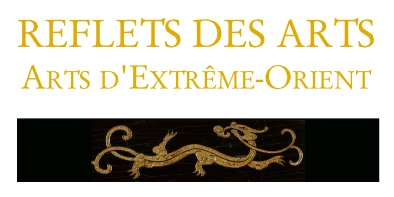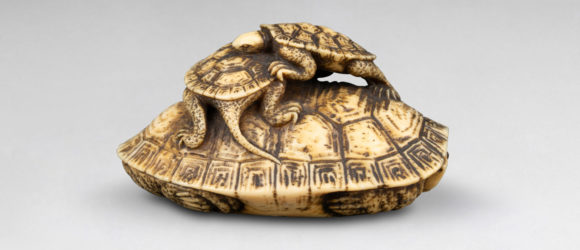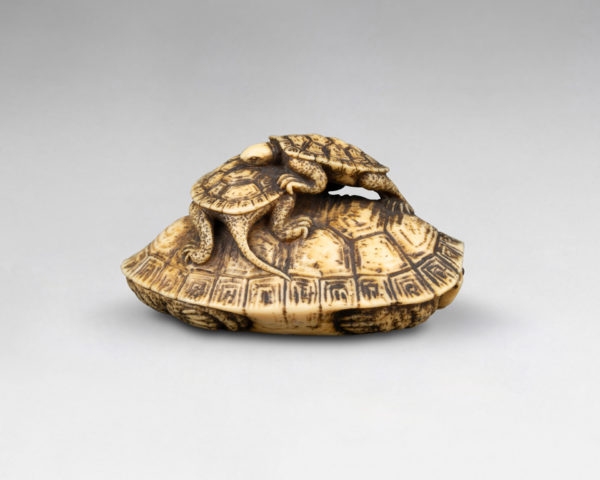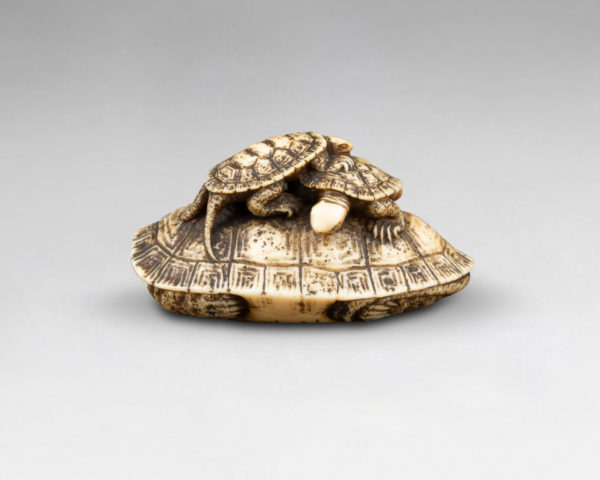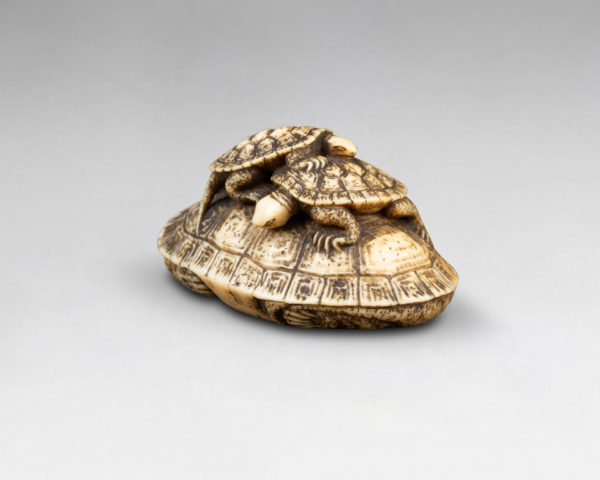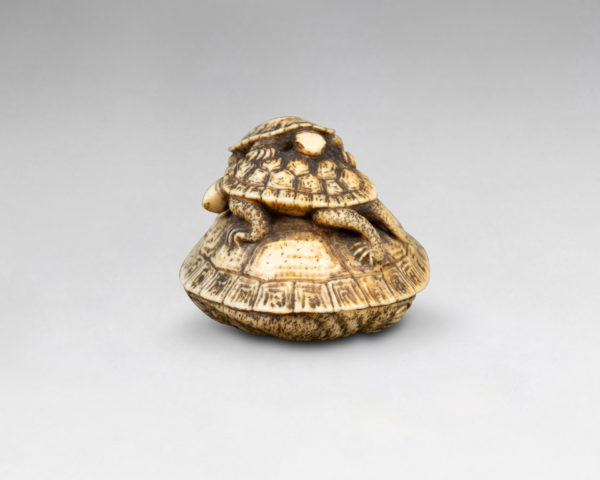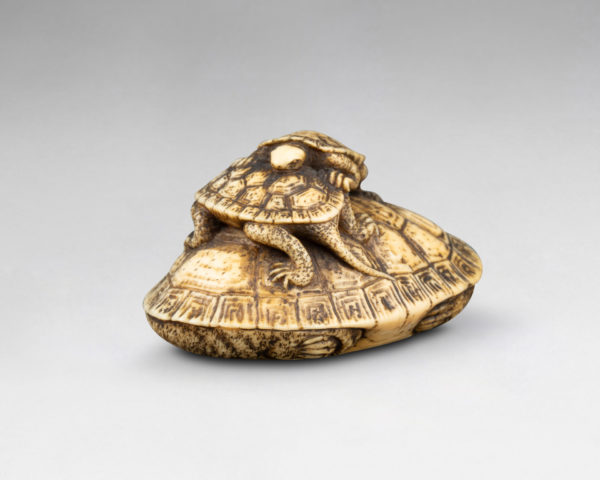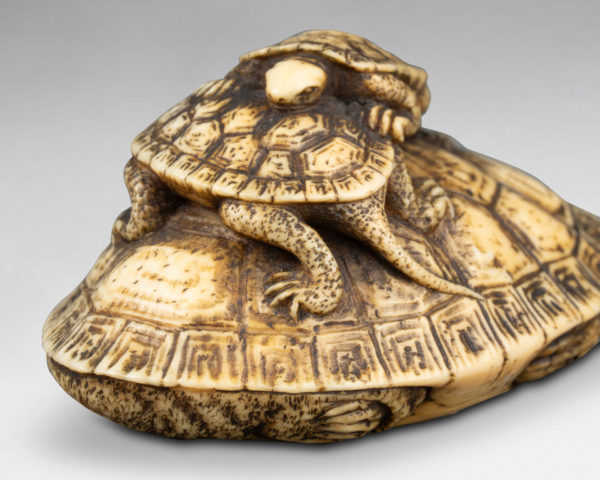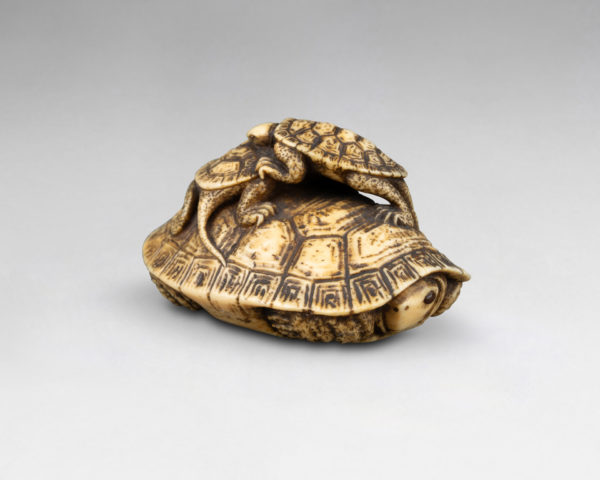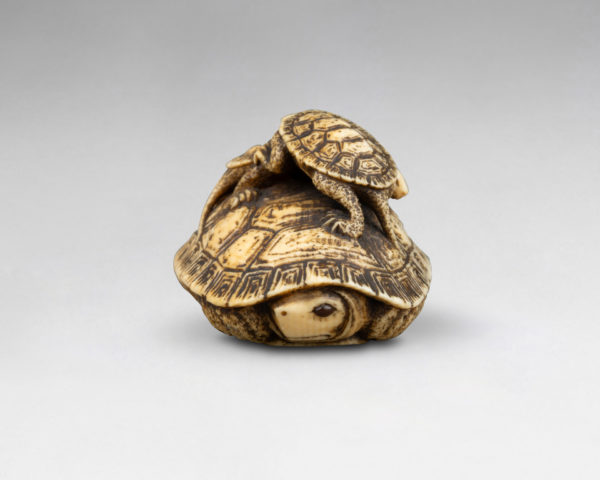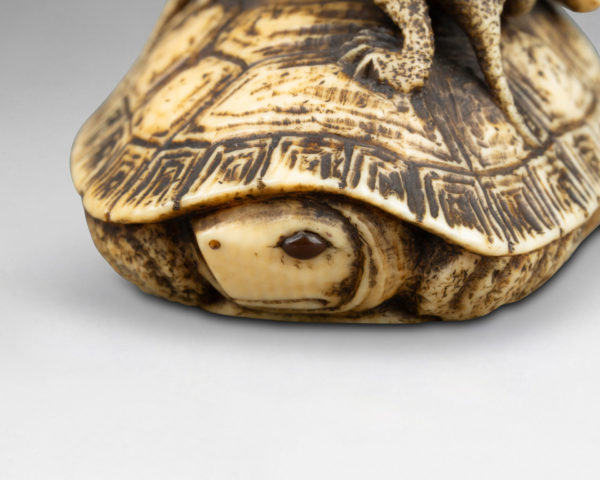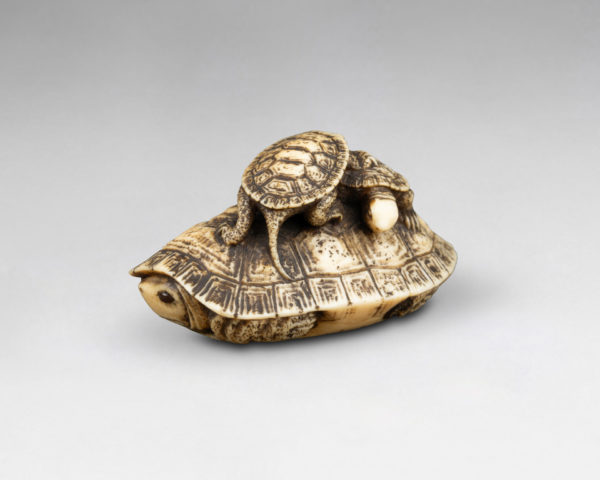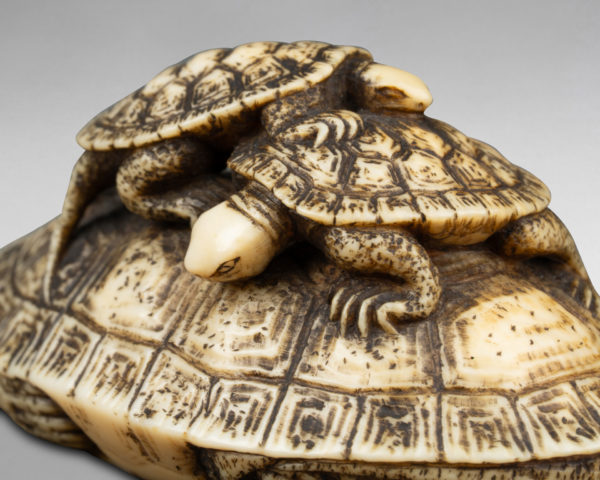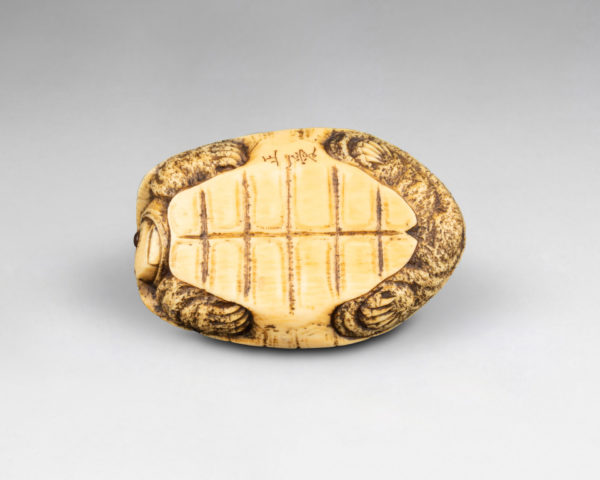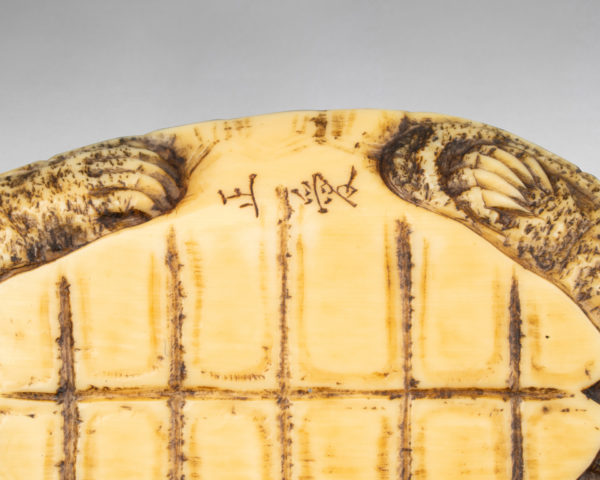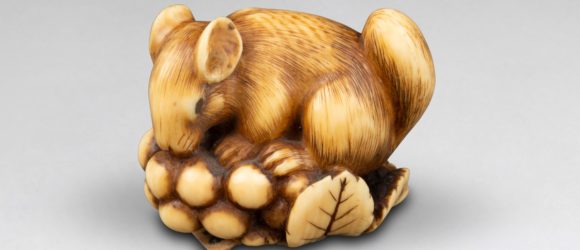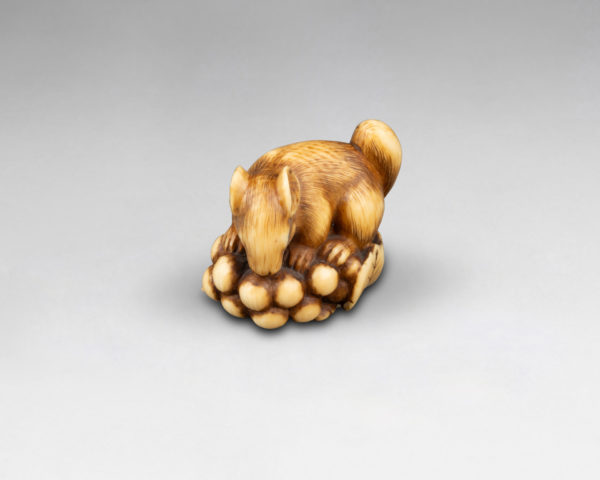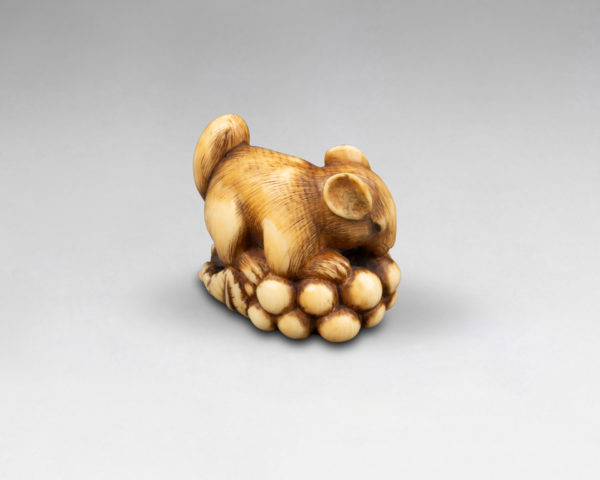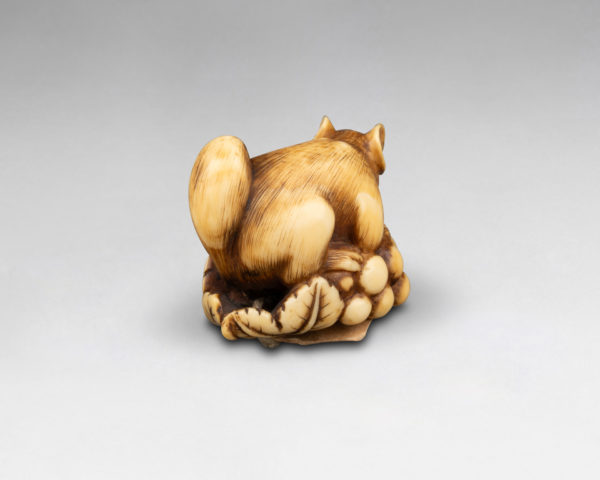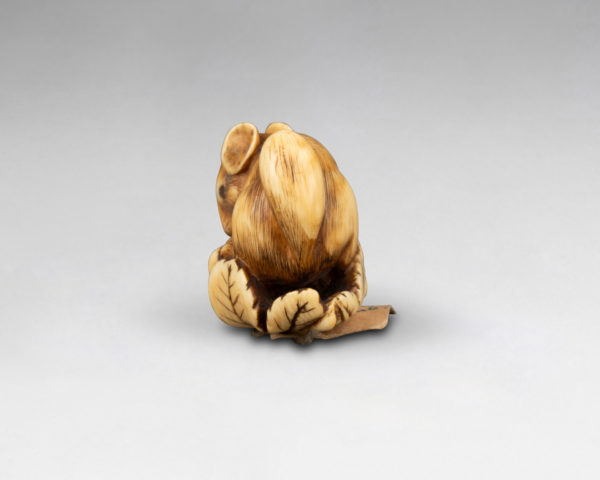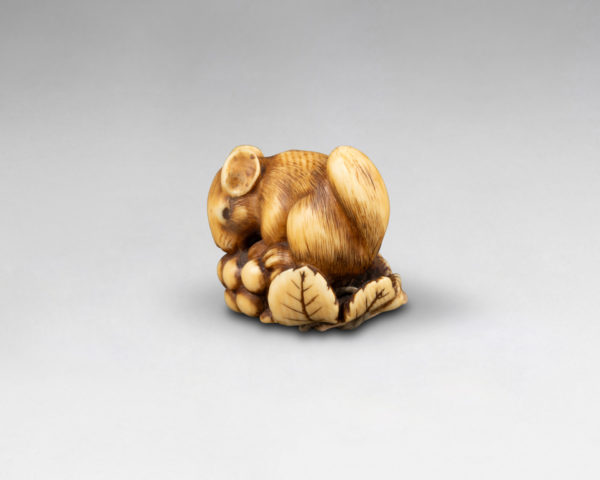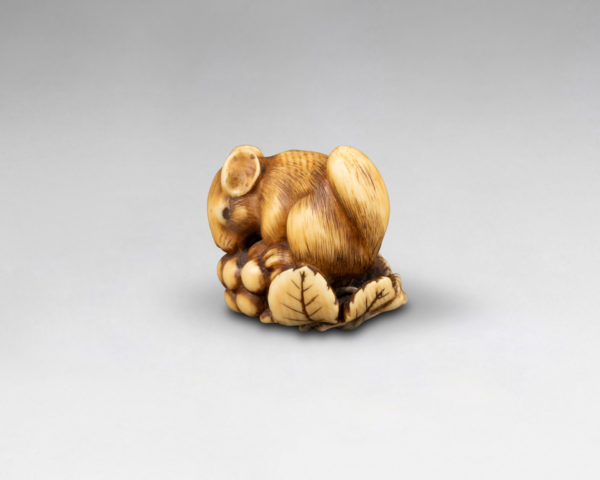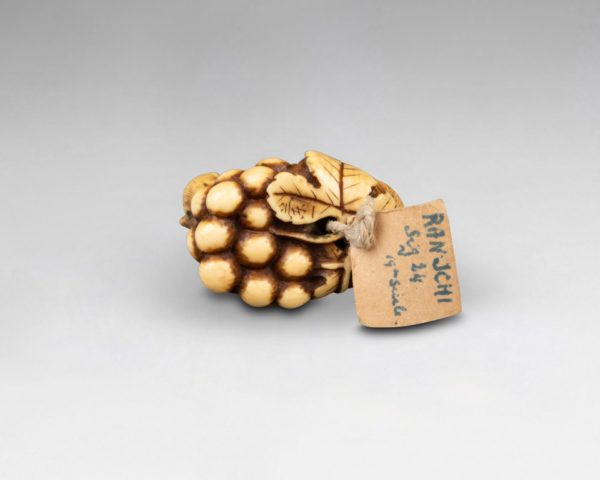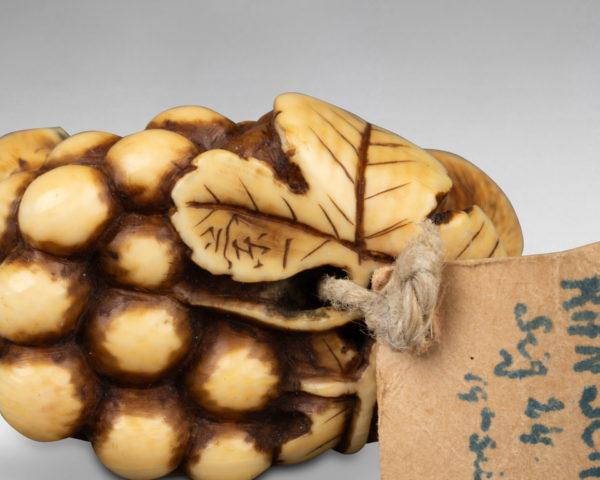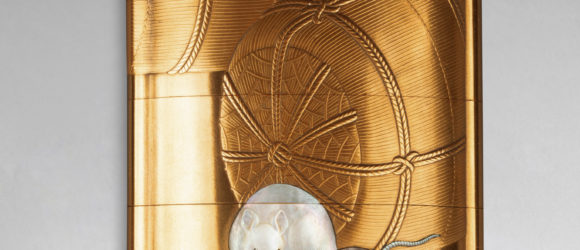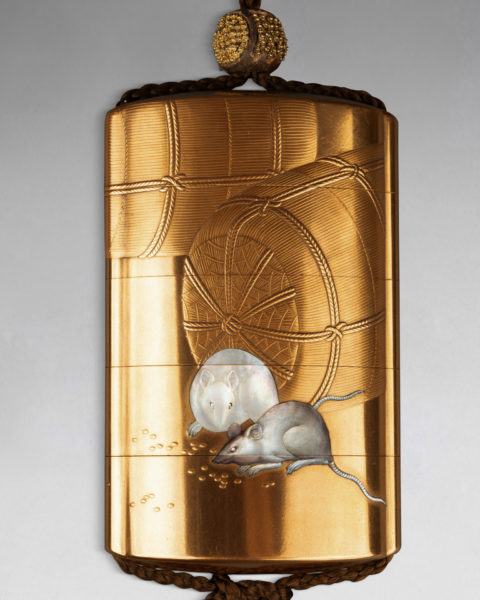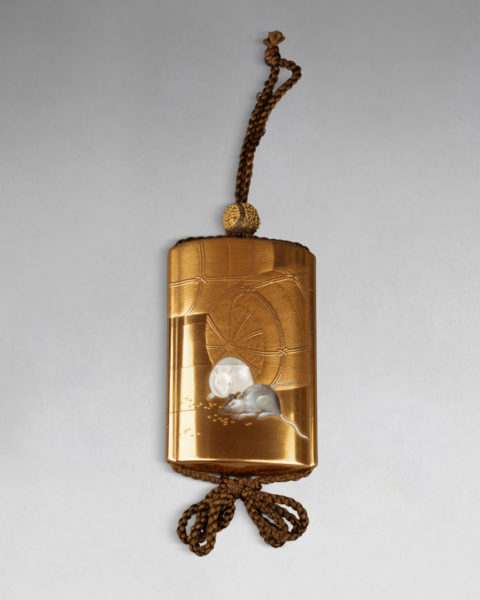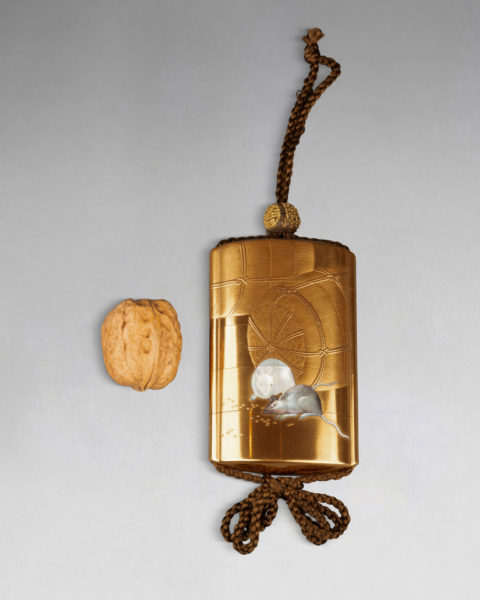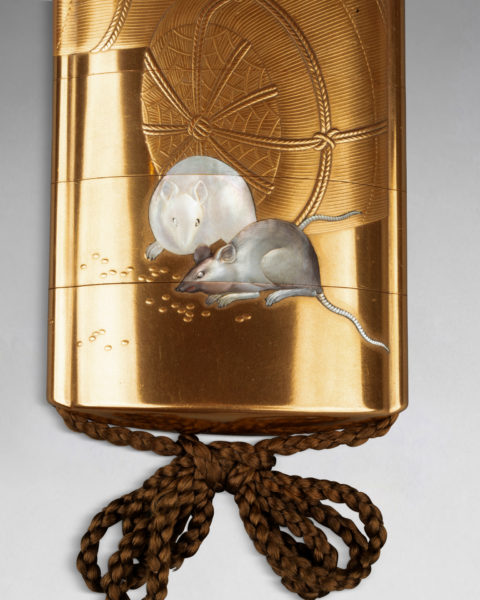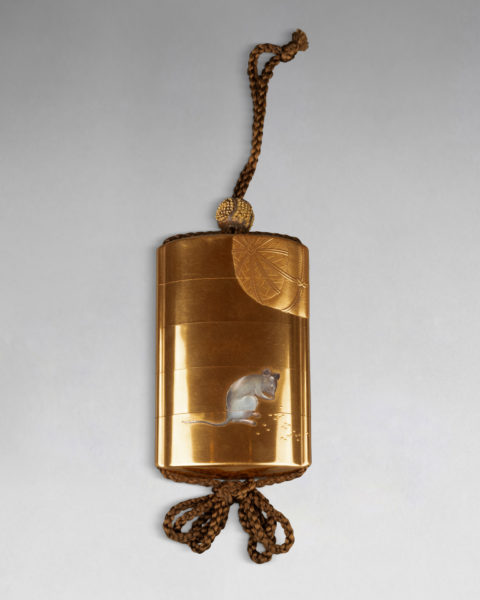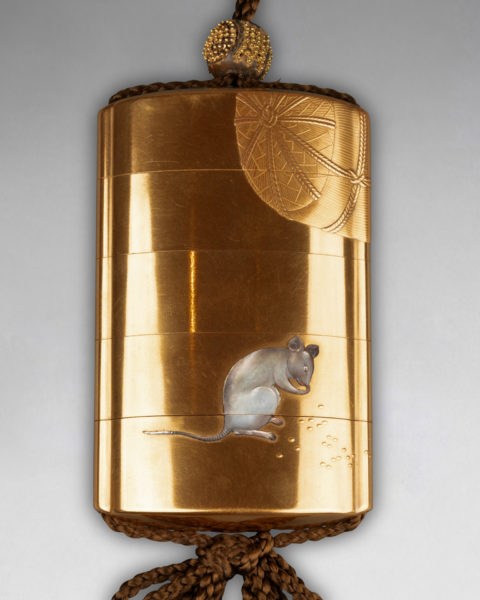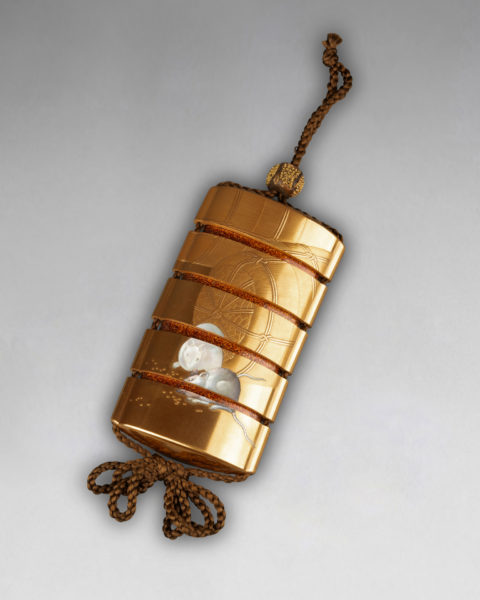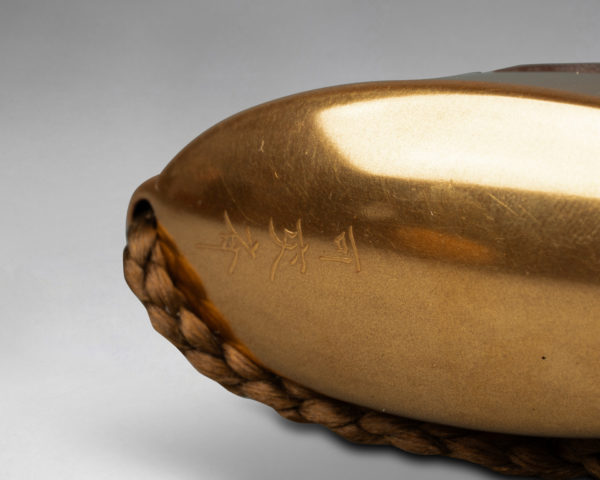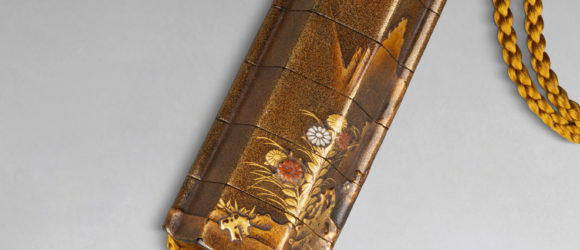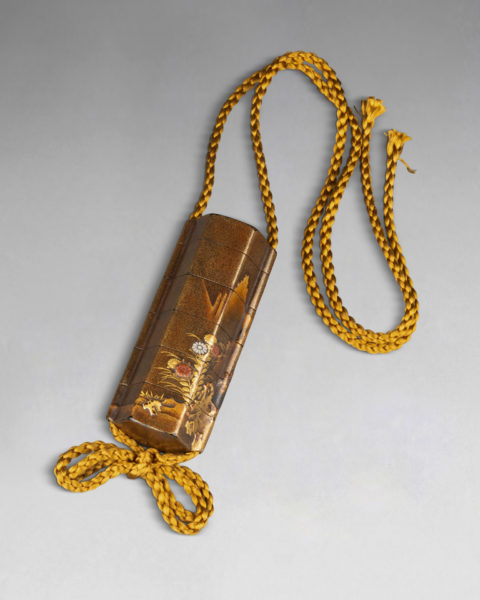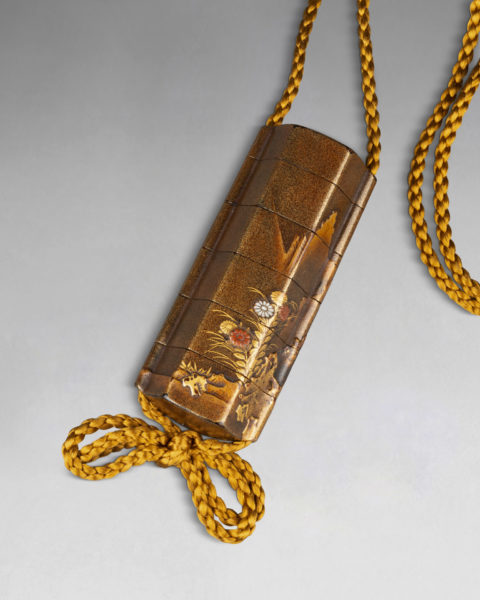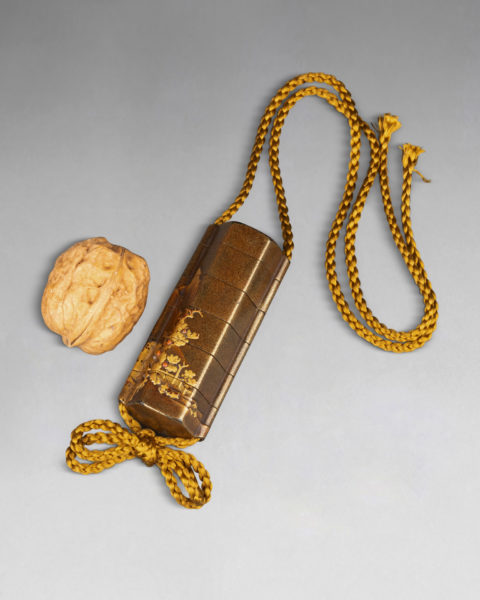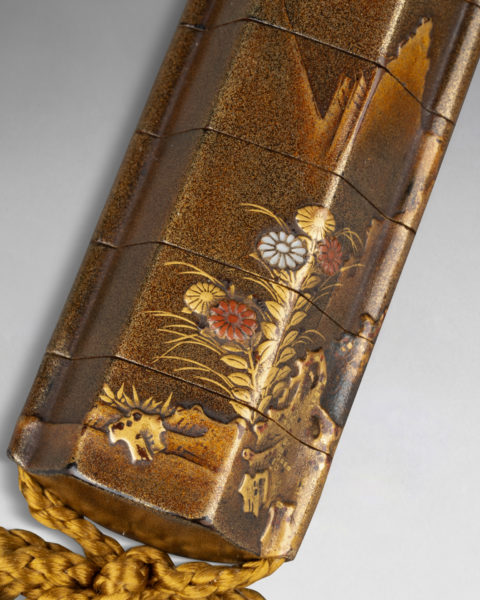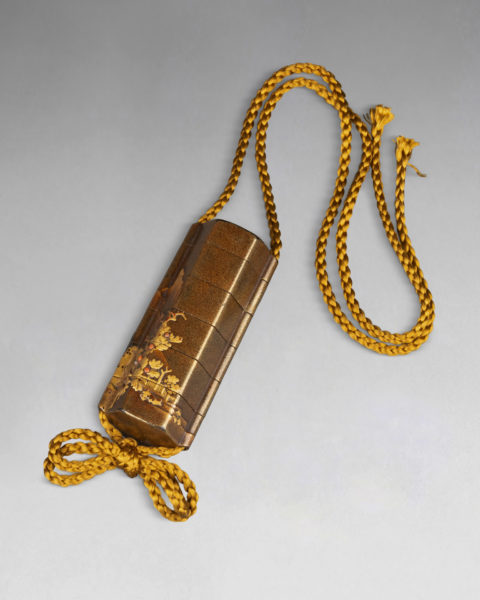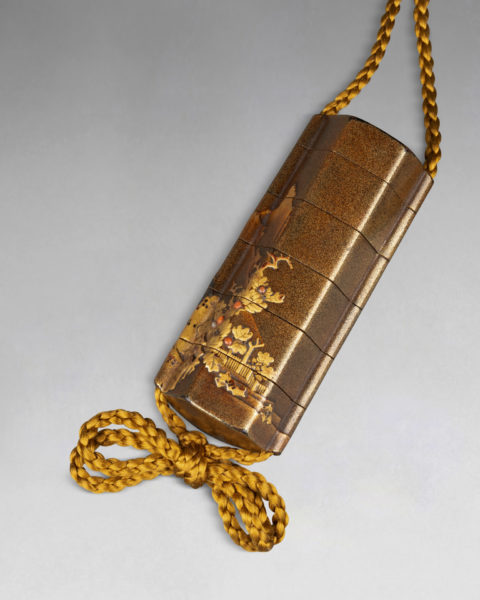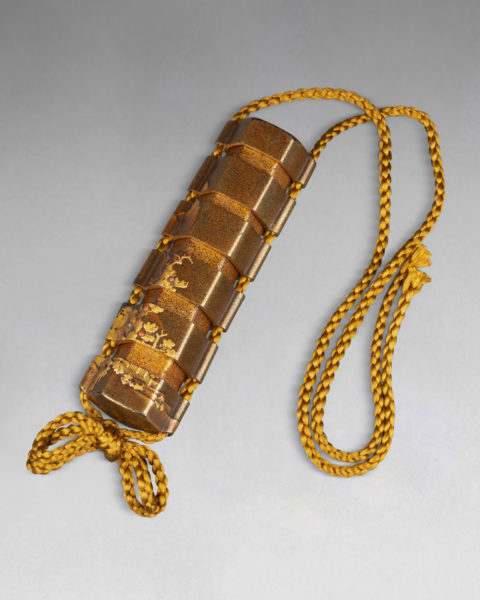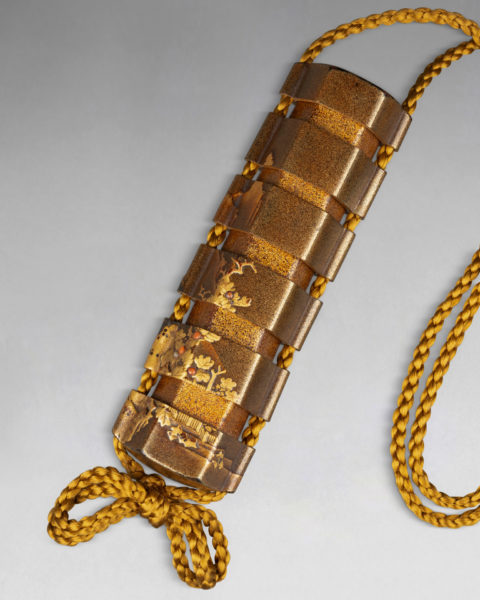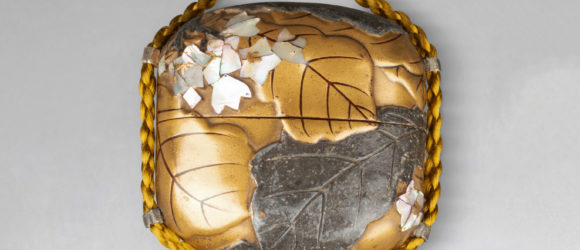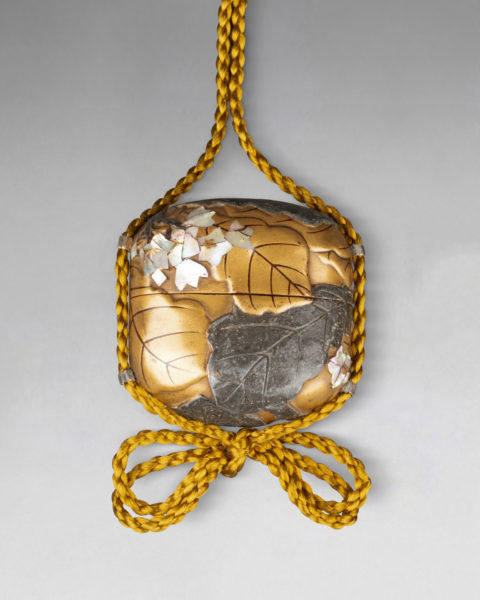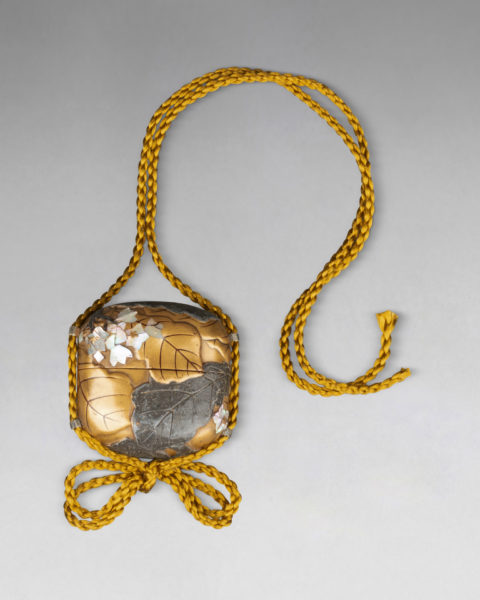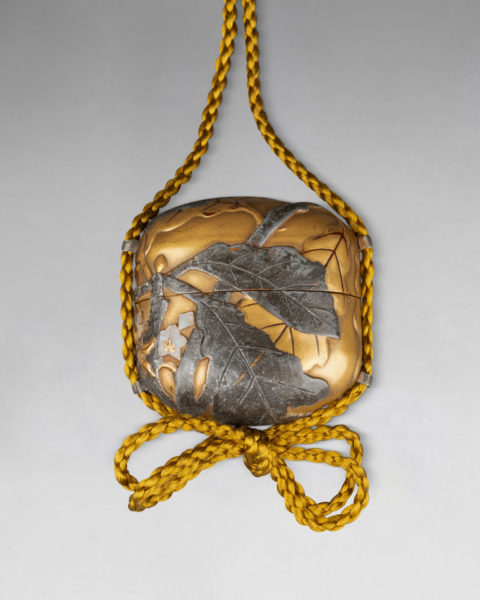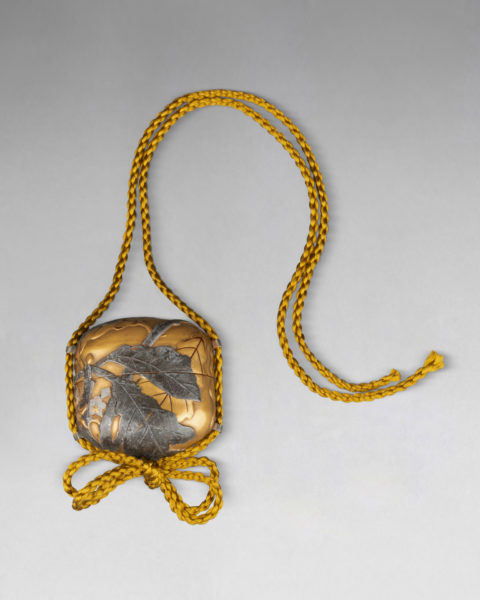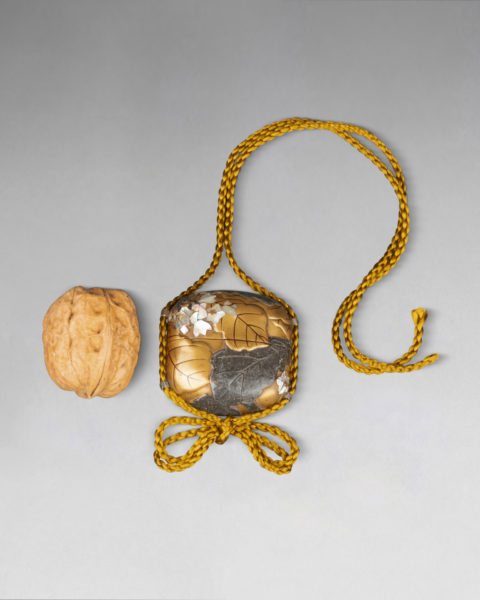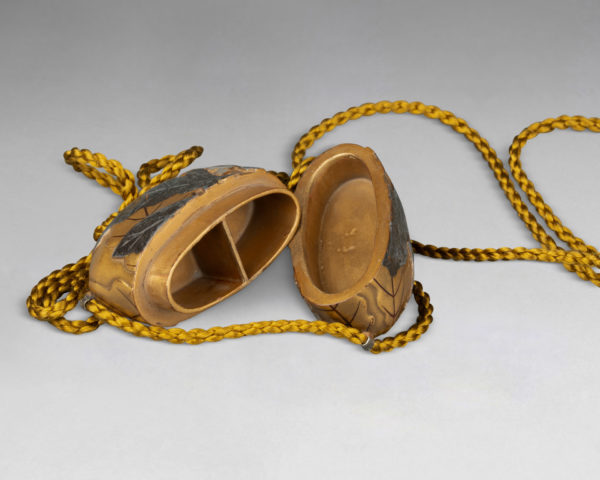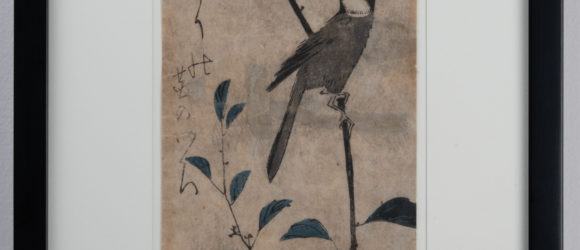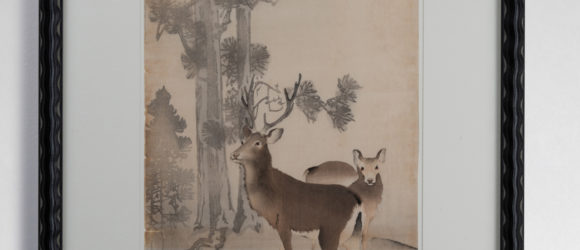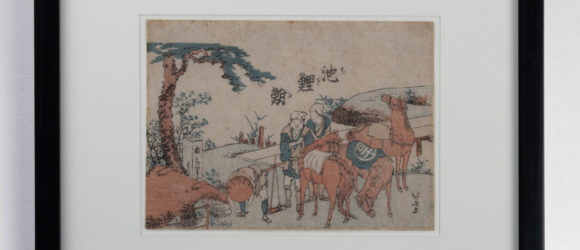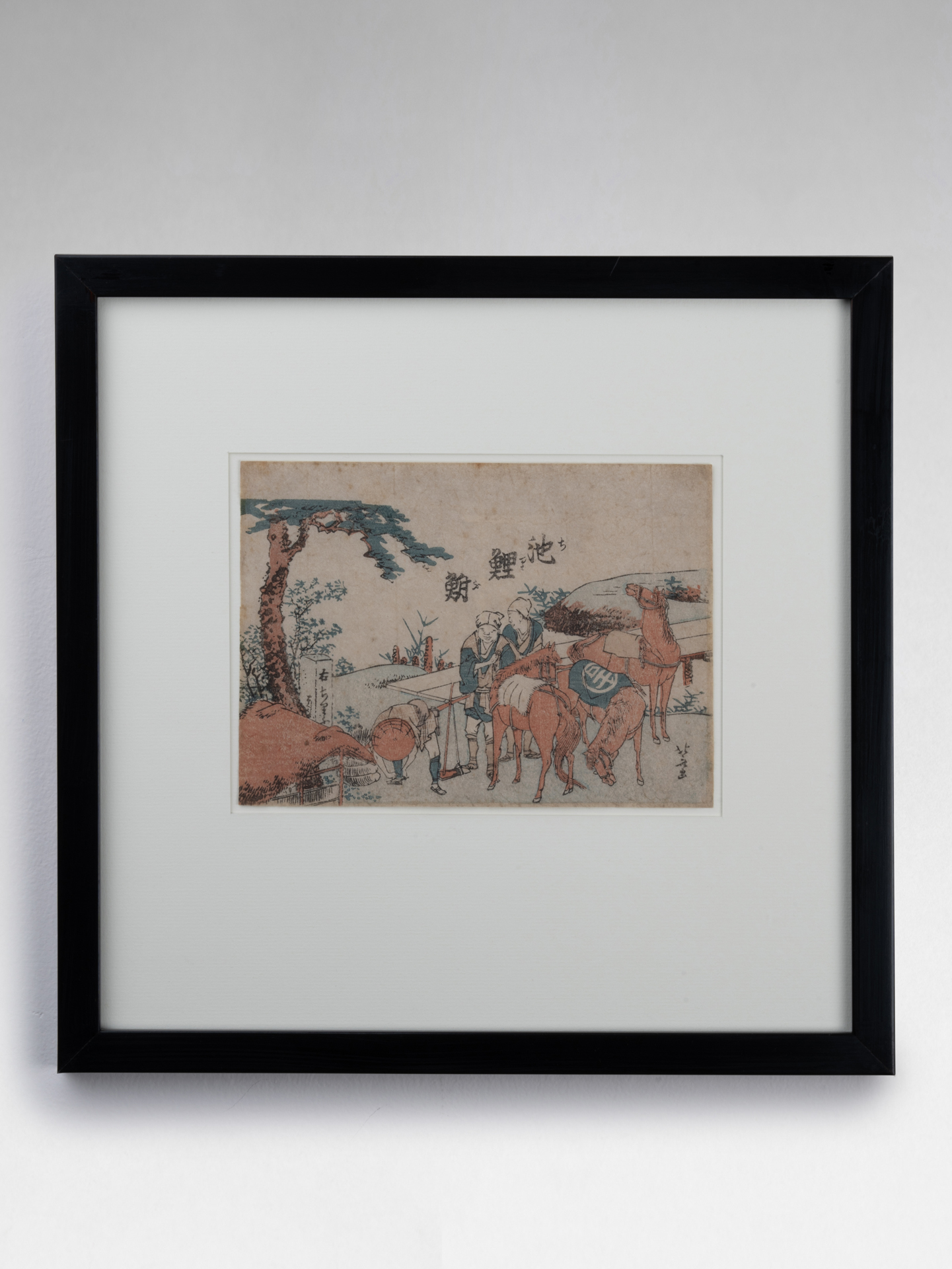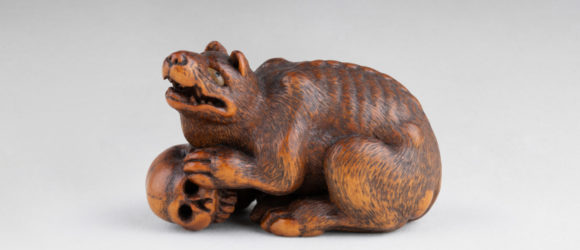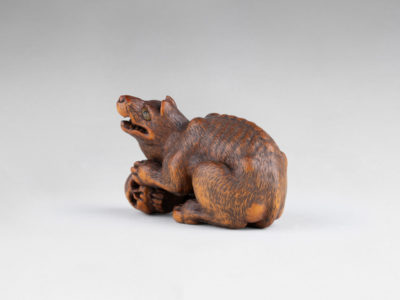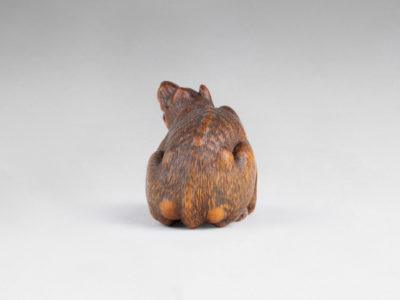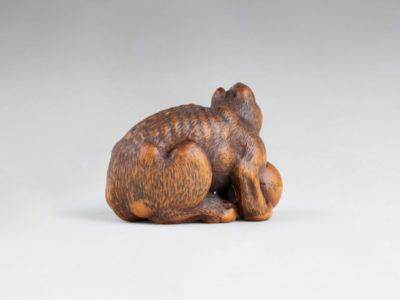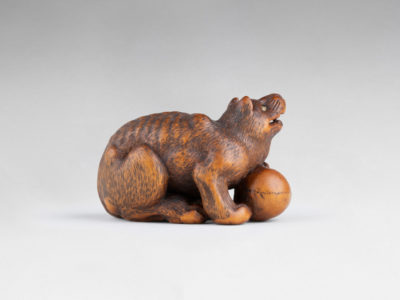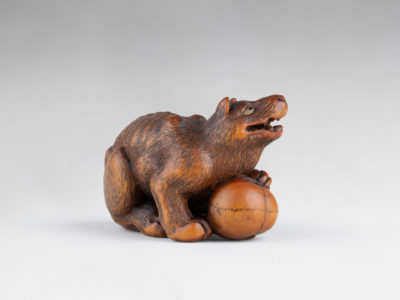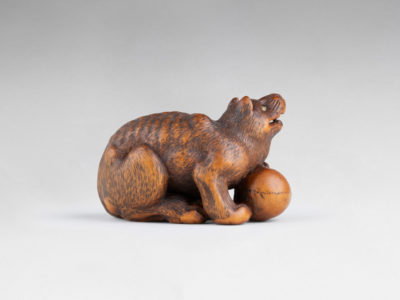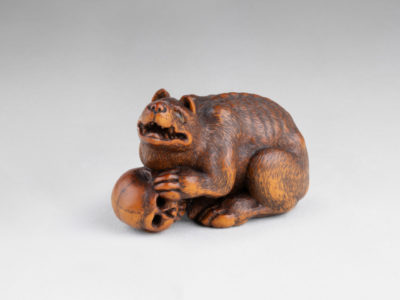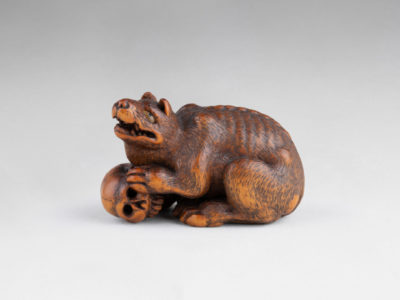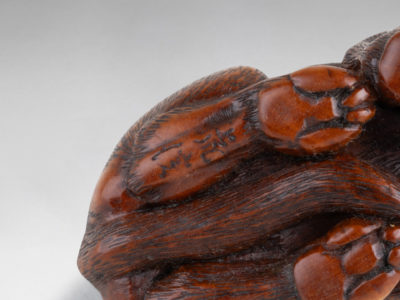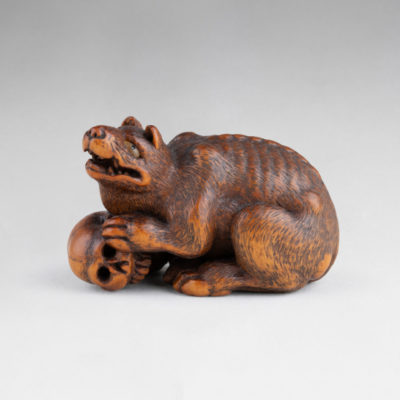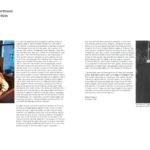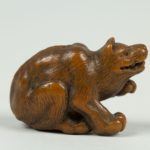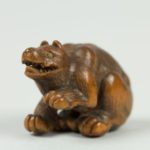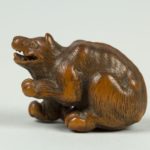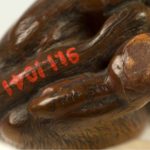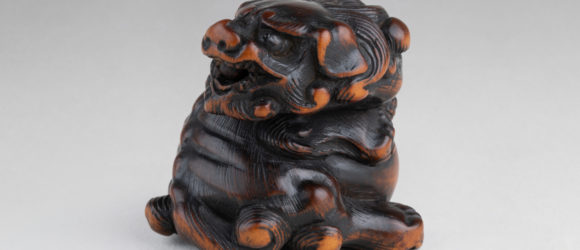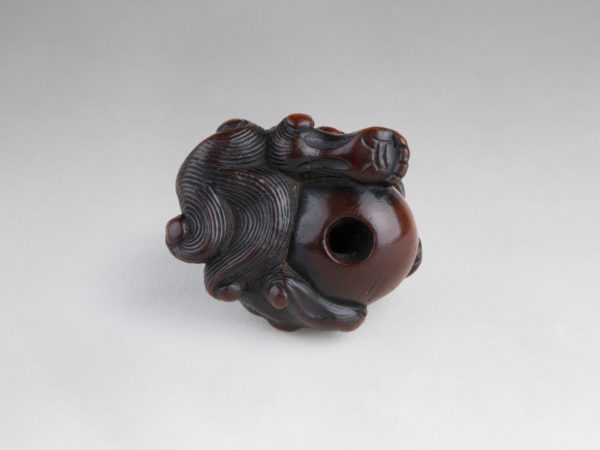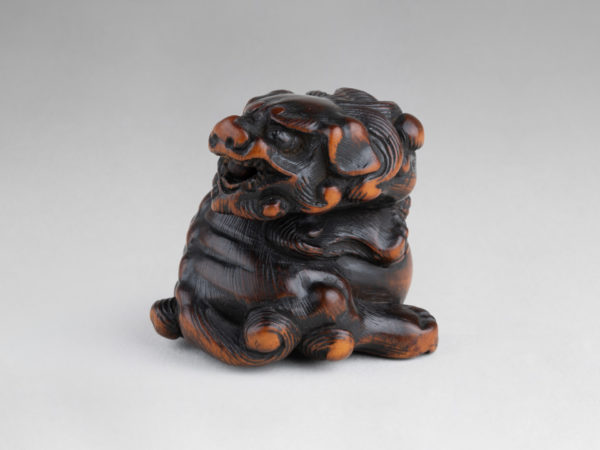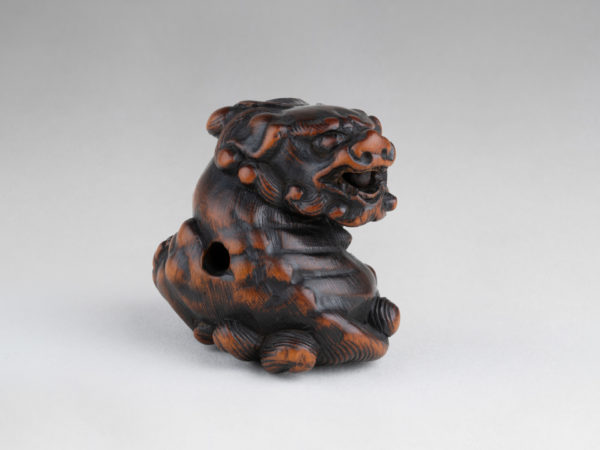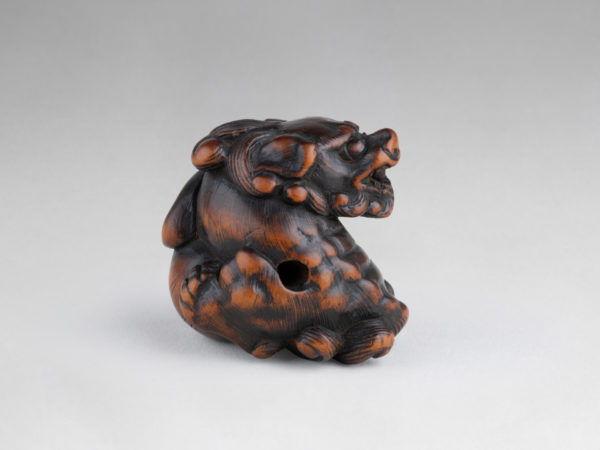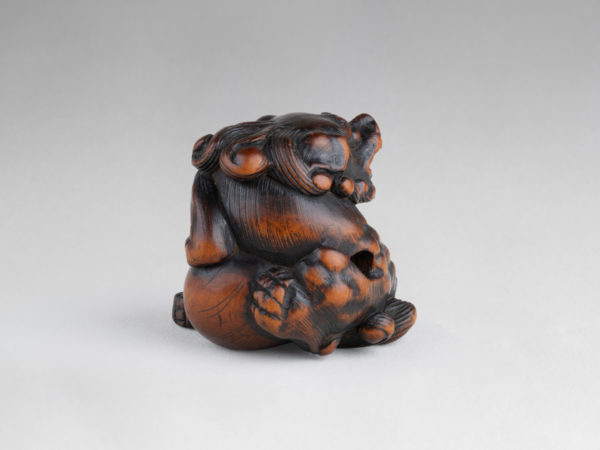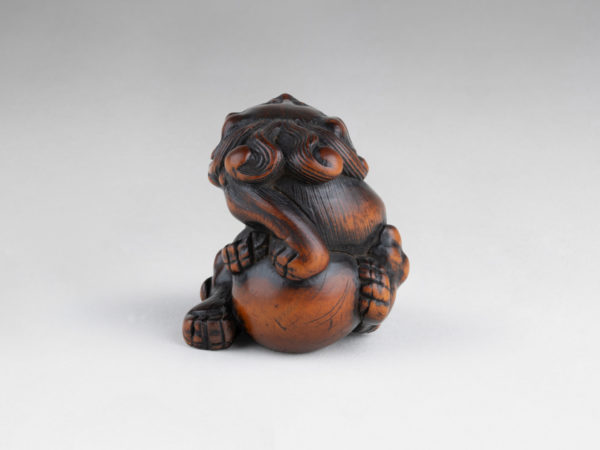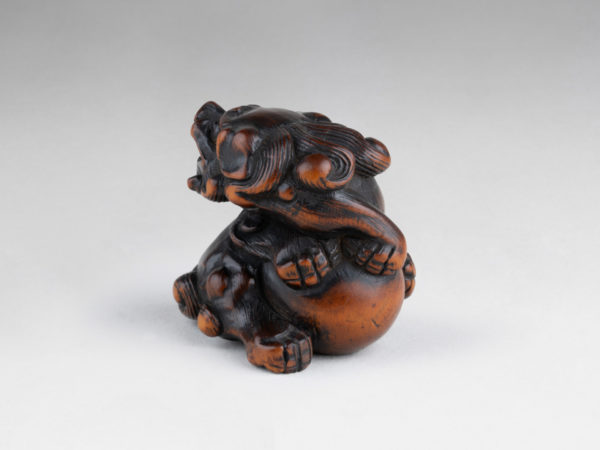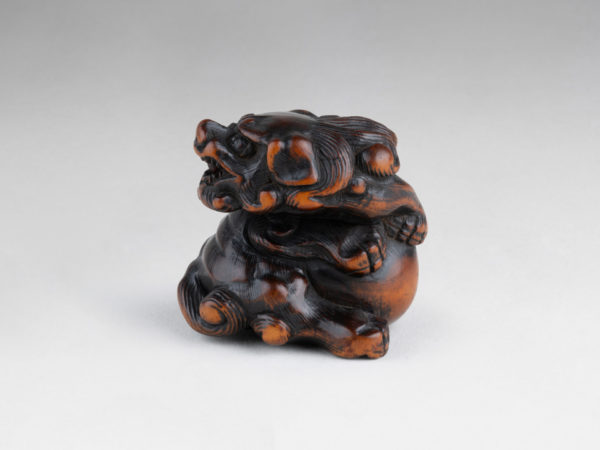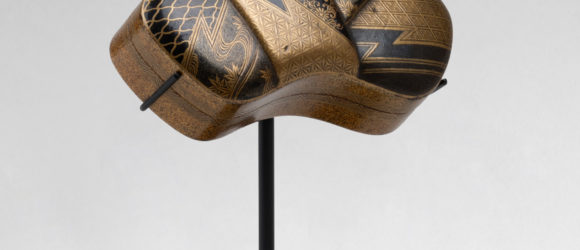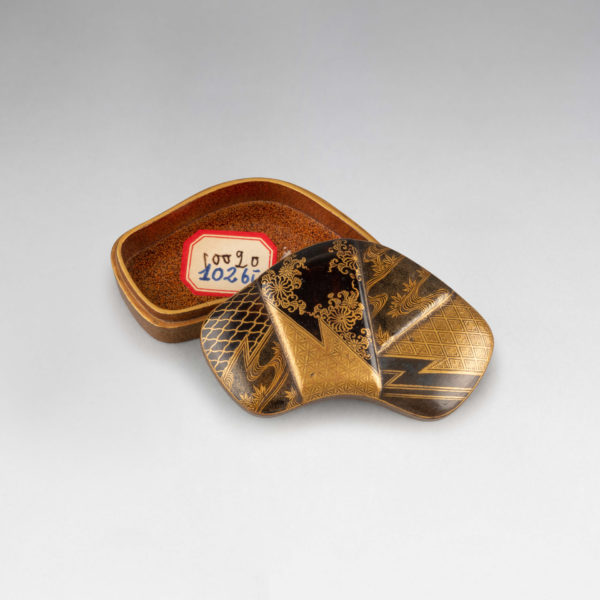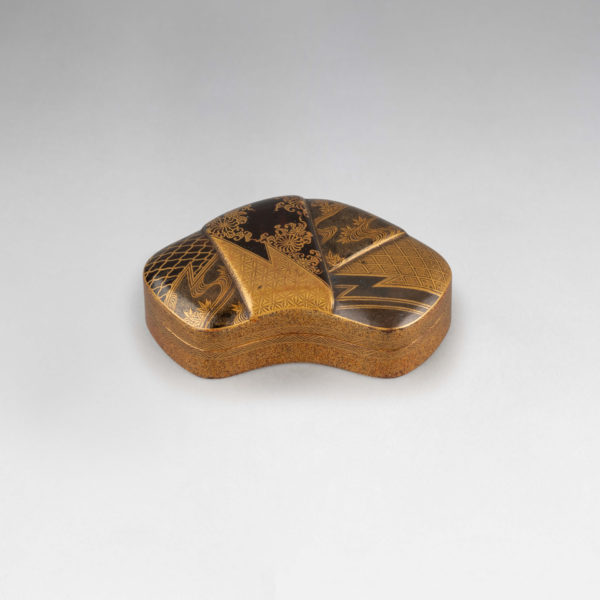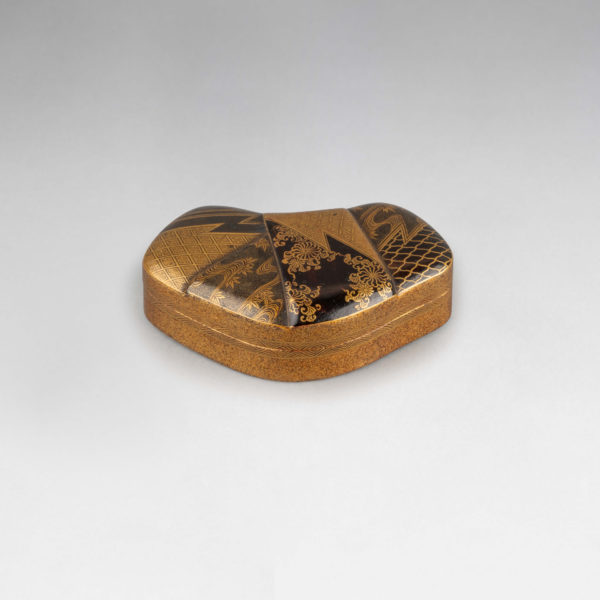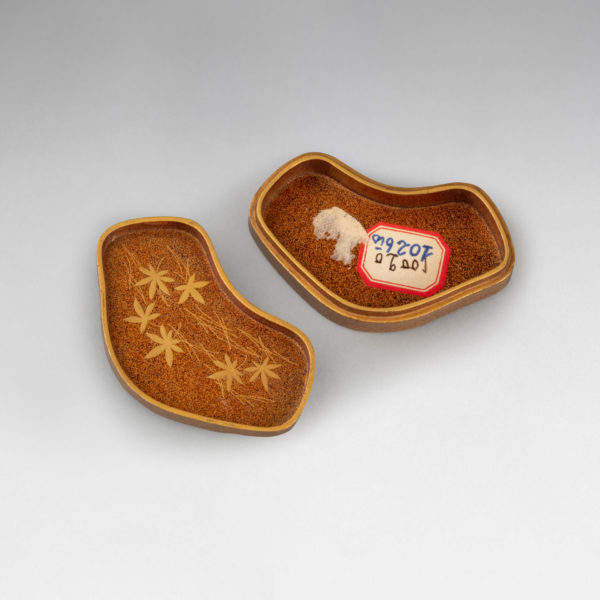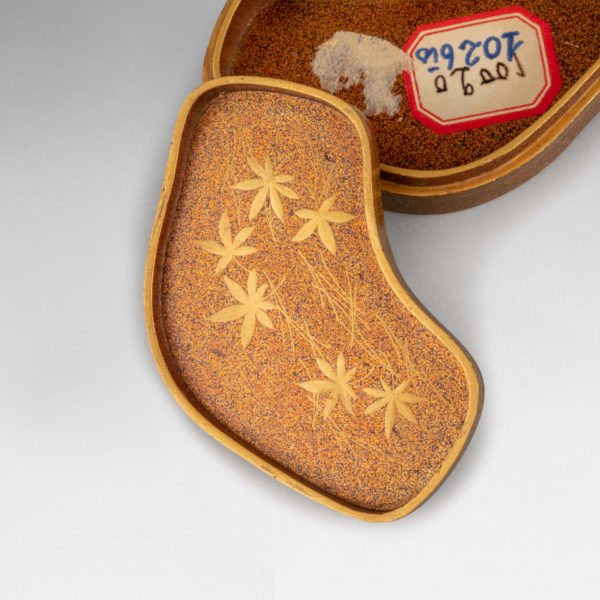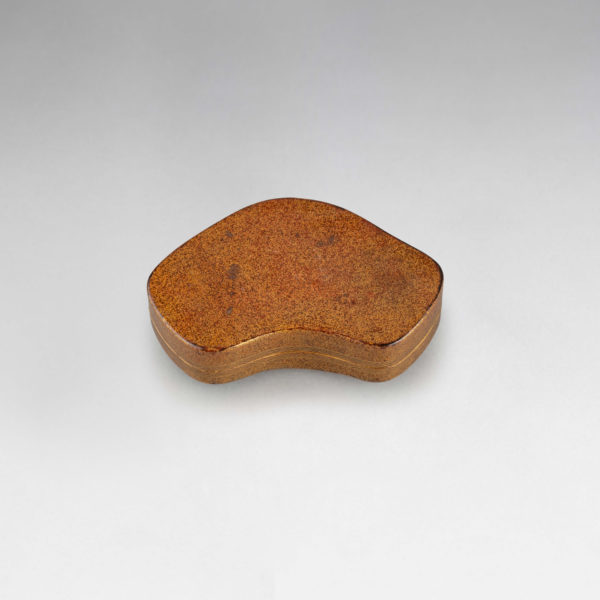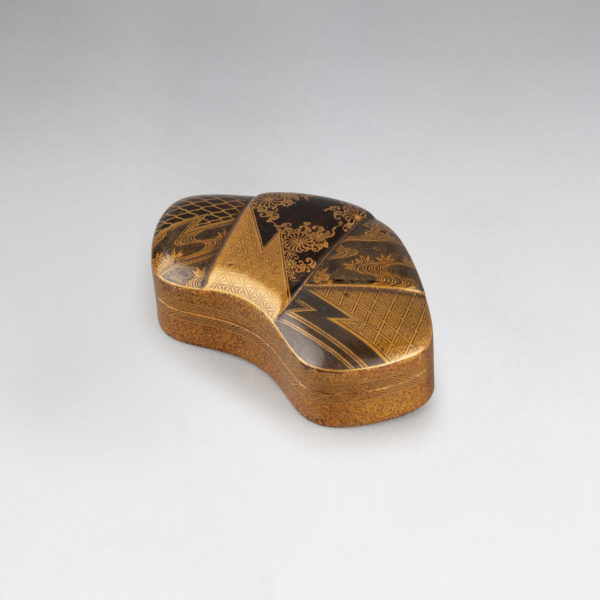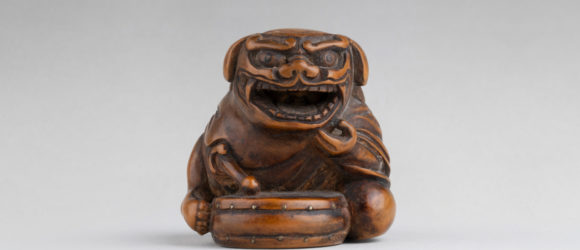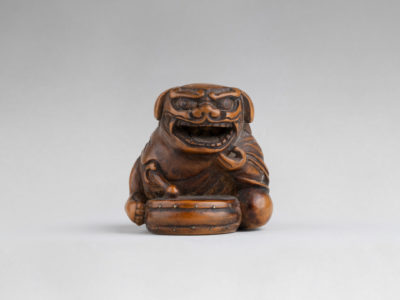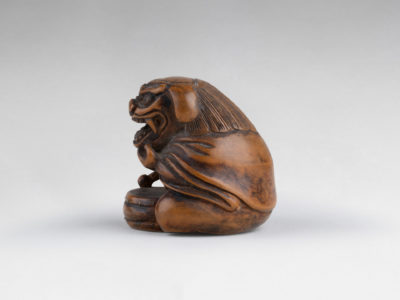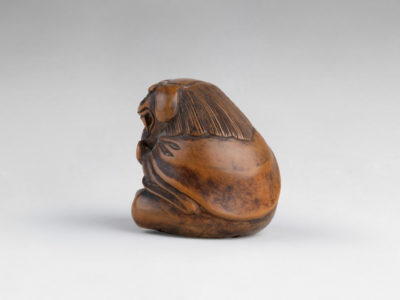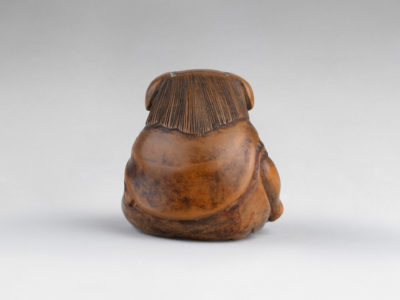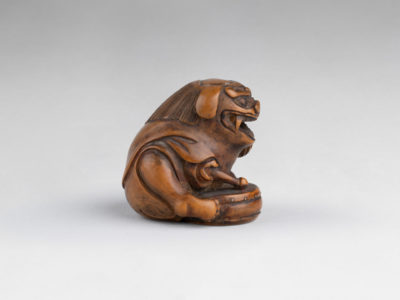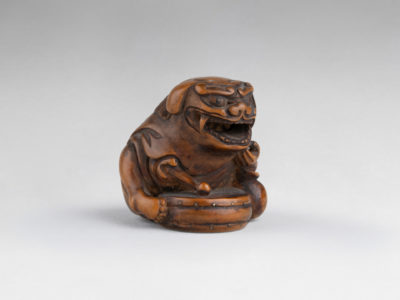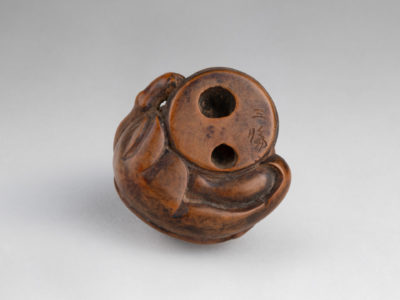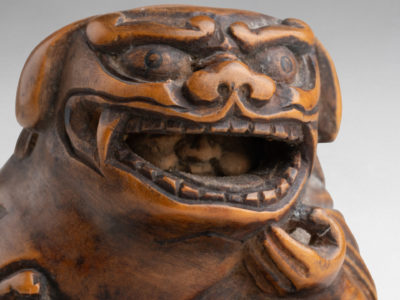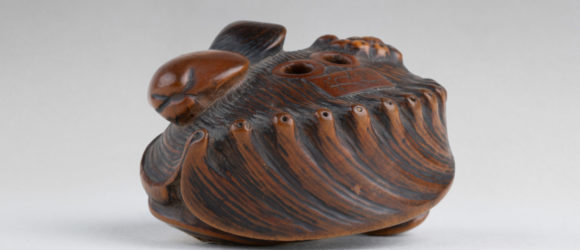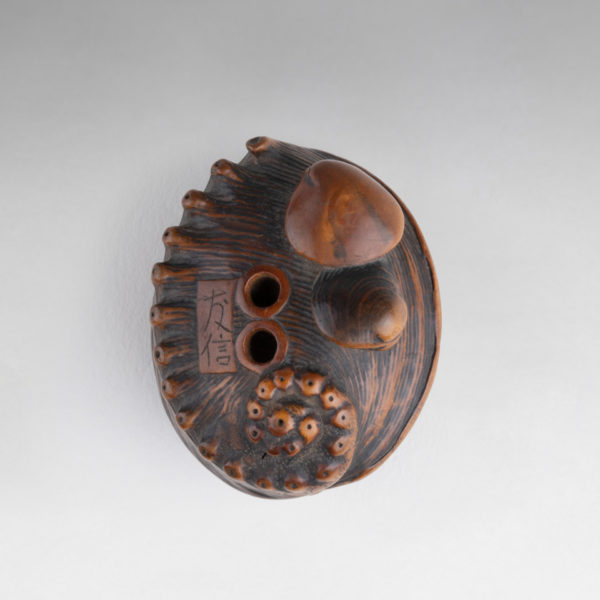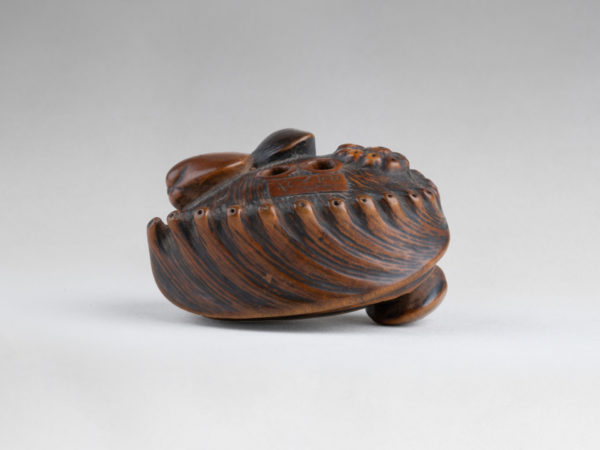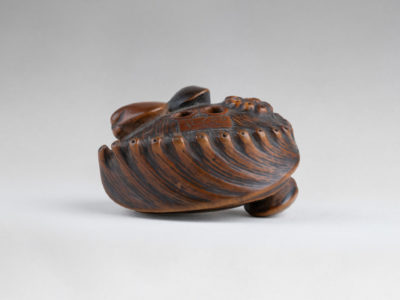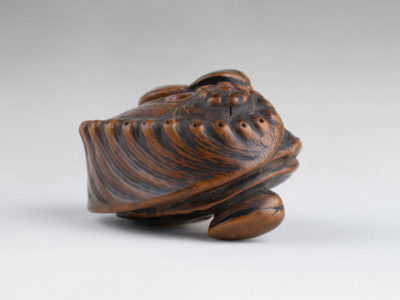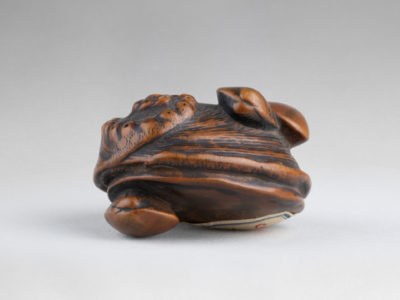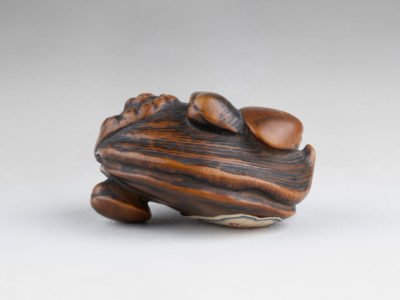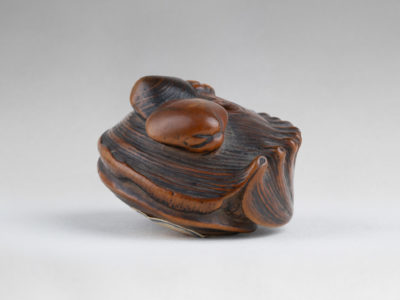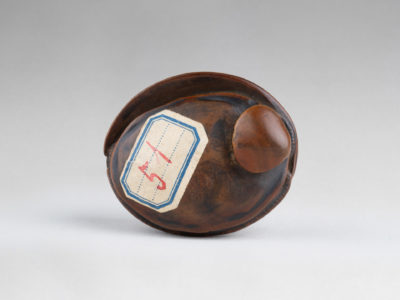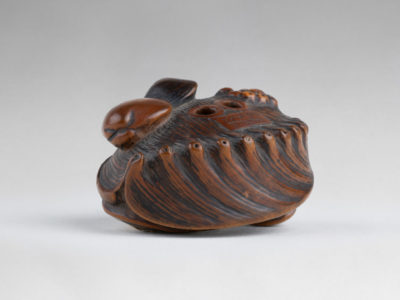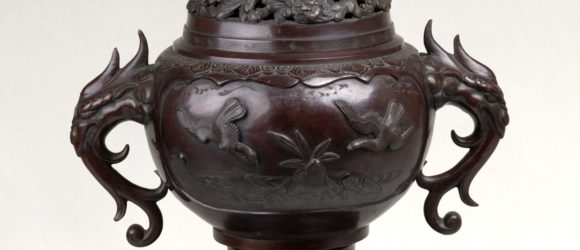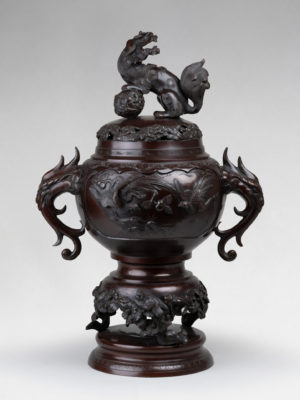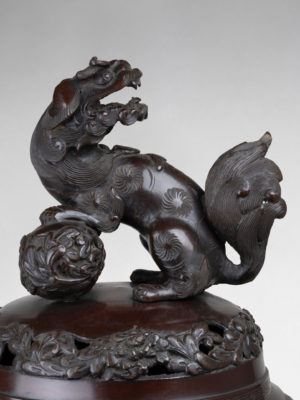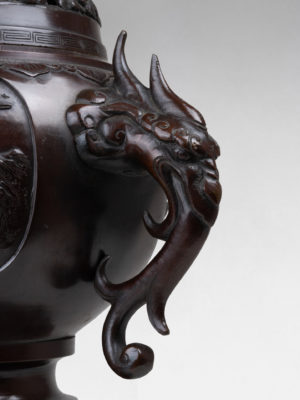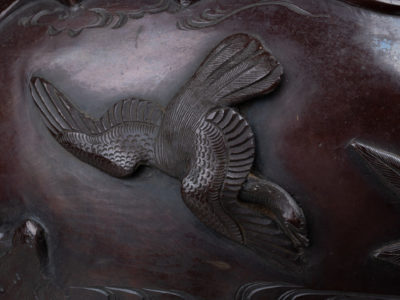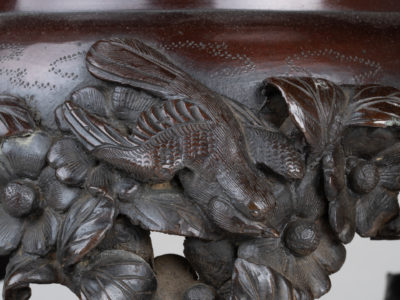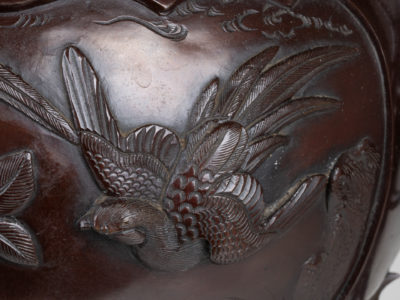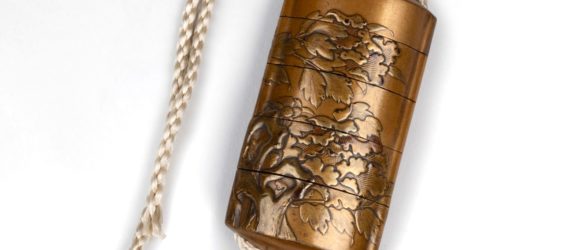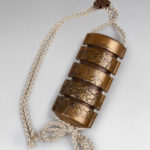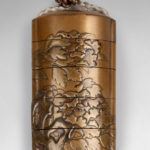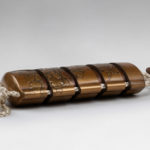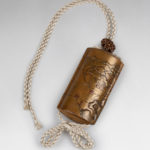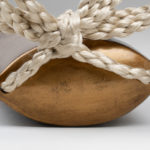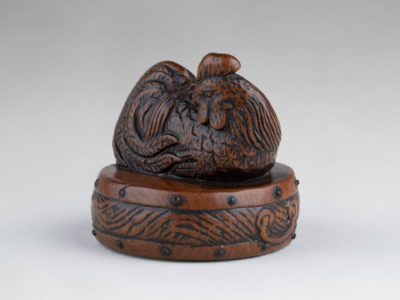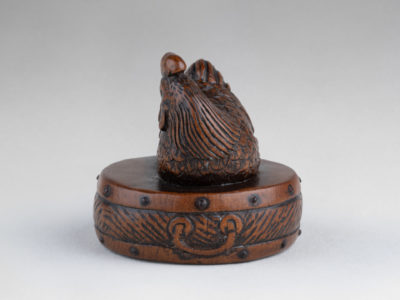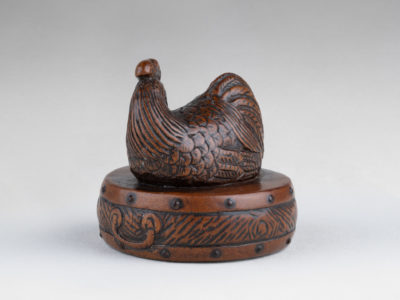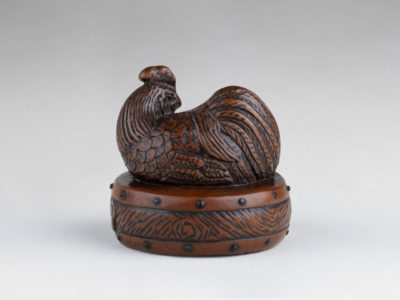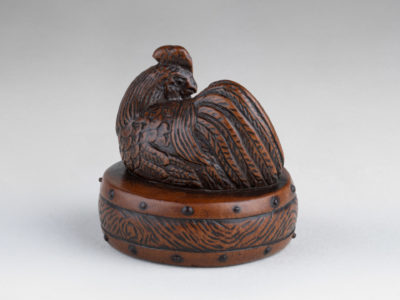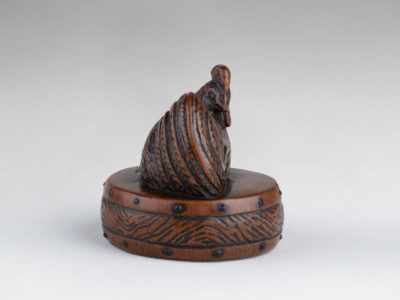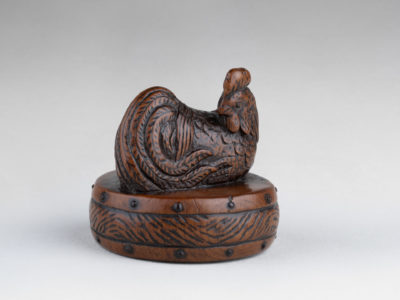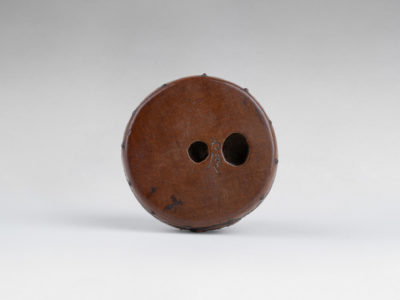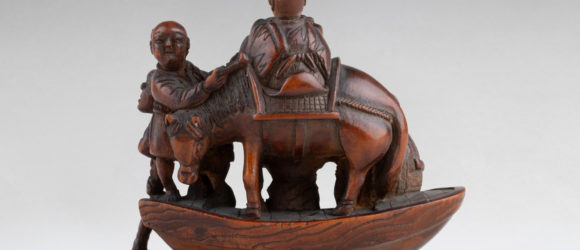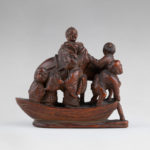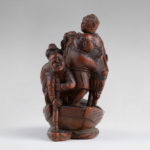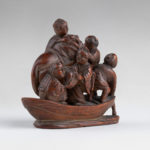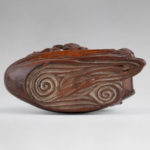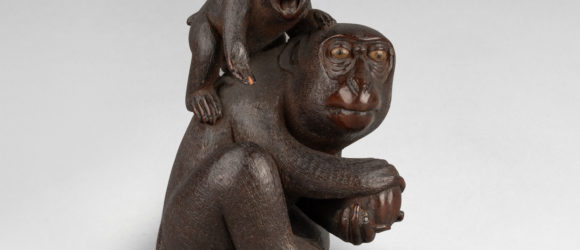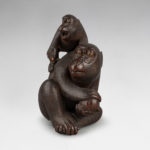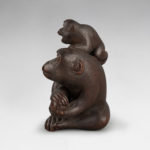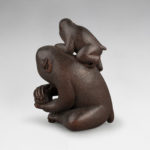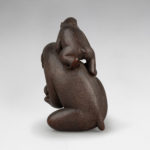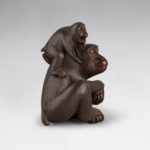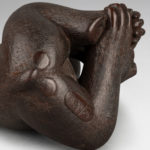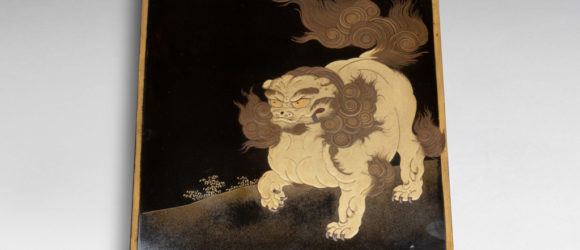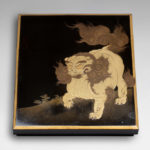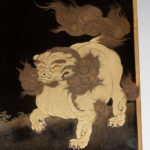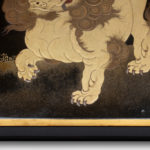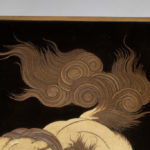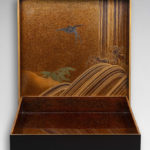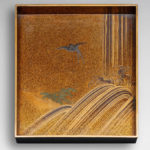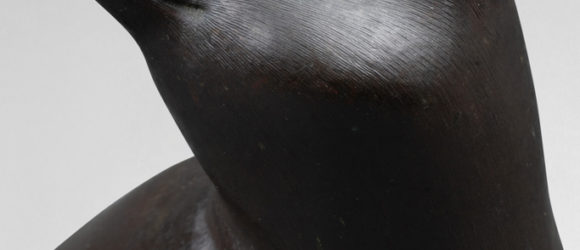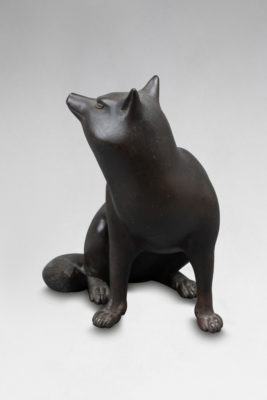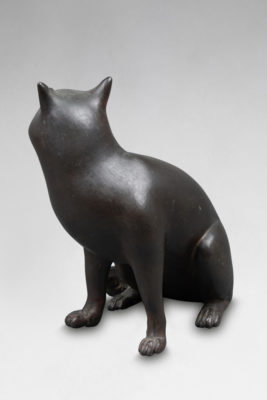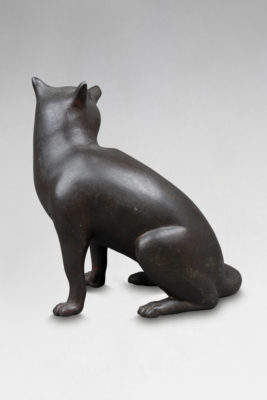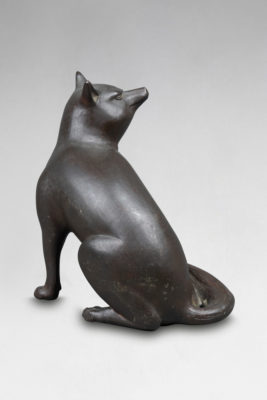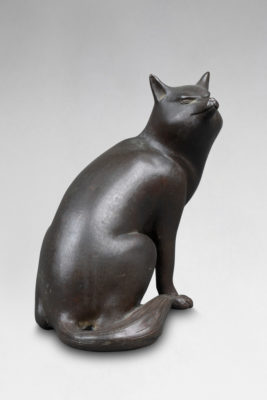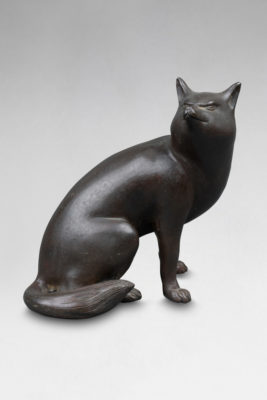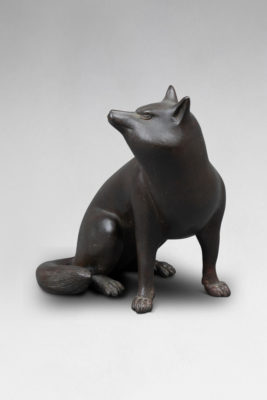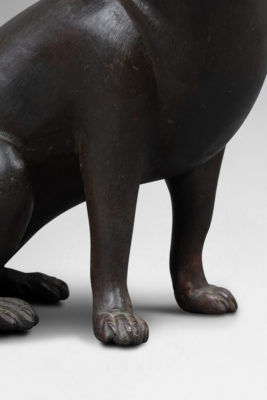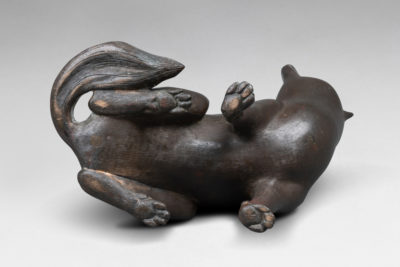Netsuke – Loir sur des fruits par Ranichi
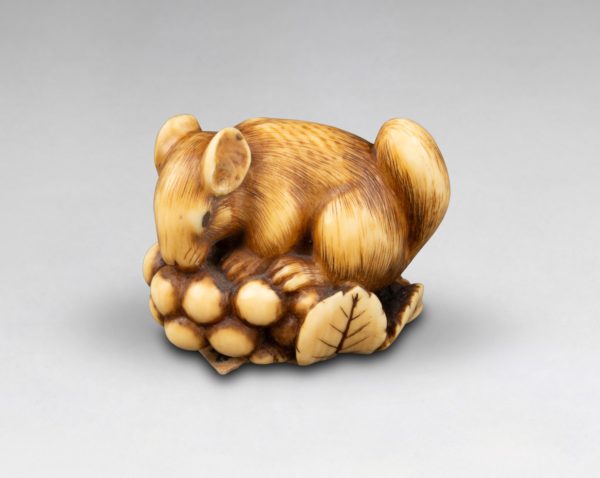
Netsuke en ivoire par Ranichi, représentant un loir perché sur une grappe de fruits. Hauteur : 2,8 cm. Japon Edo (1603-1868) fin du XVIIIe, début du XIXe siècle. CIC FR2409200296-K
Netsuke – Ivory netsuke by Ranichi representing a dormouse perched on a cluster of fruits. H: 2,8 cm. Japan Edo (1603-1868) end of 18th, early 19th century
Inro hexagonal en laque d’or
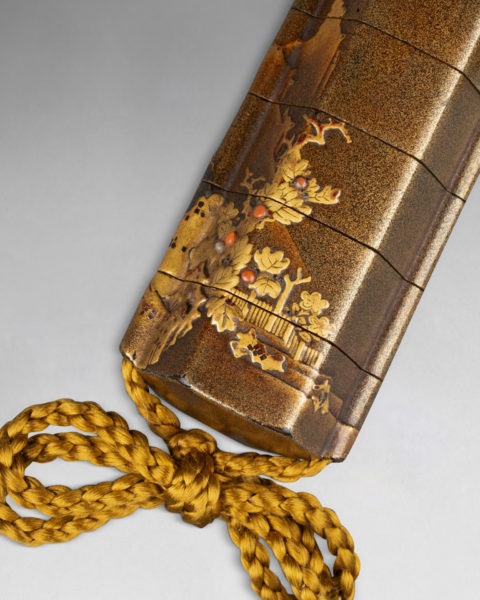
Petit inro de forme hexagonale ouvrant par cinq cases et un couvercle, en laque d’or du japon urushi, à décor incrusté de nacre et corail et kirigane de chrysanthèmes en fleurs, rochers percés et montagnes. L’intérieur en nashiji. JAPON, Époque EDO (1603-1868) XVIIIe siècle Hauteur : 7,5 cm
Small hexagonal inro opening with five cases and a lid, Japanese urushi gold lacquer, with inlaid of mother-of-pearl and coral and kirigane of flowering chrysanthemums, pierced rocks and mountains. Nashiji inside. JAPAN, EDO Period (1603-1868) 18th century. Height: 7.5cm
Inro – école de Rimpa, Ogata Korin
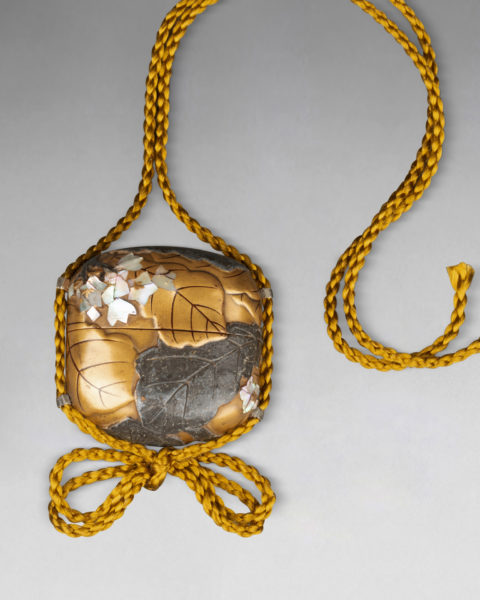
Inro – Rare petit modèle en laque d’or urushi, typique de la production dite des laques de Koetsu, école Rimpa ou école de Kôrin – Ogata Korin (1658-1716). Formes fortement bombées très caractéristiques, espace intérieur divisé en deux parties, utilisation de matériaux divers tels que : argent, or, nacre, et plomb et apparente simplicité avec concision du trait, sont autant de caractéristiques de cette production unique. Il s’agit ici d’un petit modèle à décor de fleurs et feuillages. Hauteur : 4 cm. Largeur : 4,2 cm. Japon Edo, 18e siècle.
Inro – Unusual and small model of urushi gold lacquer, typical of the Koetsu lacquers, Rimpa school or Kôrin school – Ogata Korin (1658-1716). Very characteristic strongly rounded shapes, interior space divided into two parts, use of various materials such as: silver, gold, mother-of-pearl, and lead and apparent simplicity with conciseness of line, are all characteristics of this unique production. This is a small model decorated with flowers and leaves. Height: 4 cm. Width: 4.2cm. Edo Japan, 18th century.
Prix sur demande – Price on request
Par Utagawa Hiroshige – Série des fleurs et oiseaux
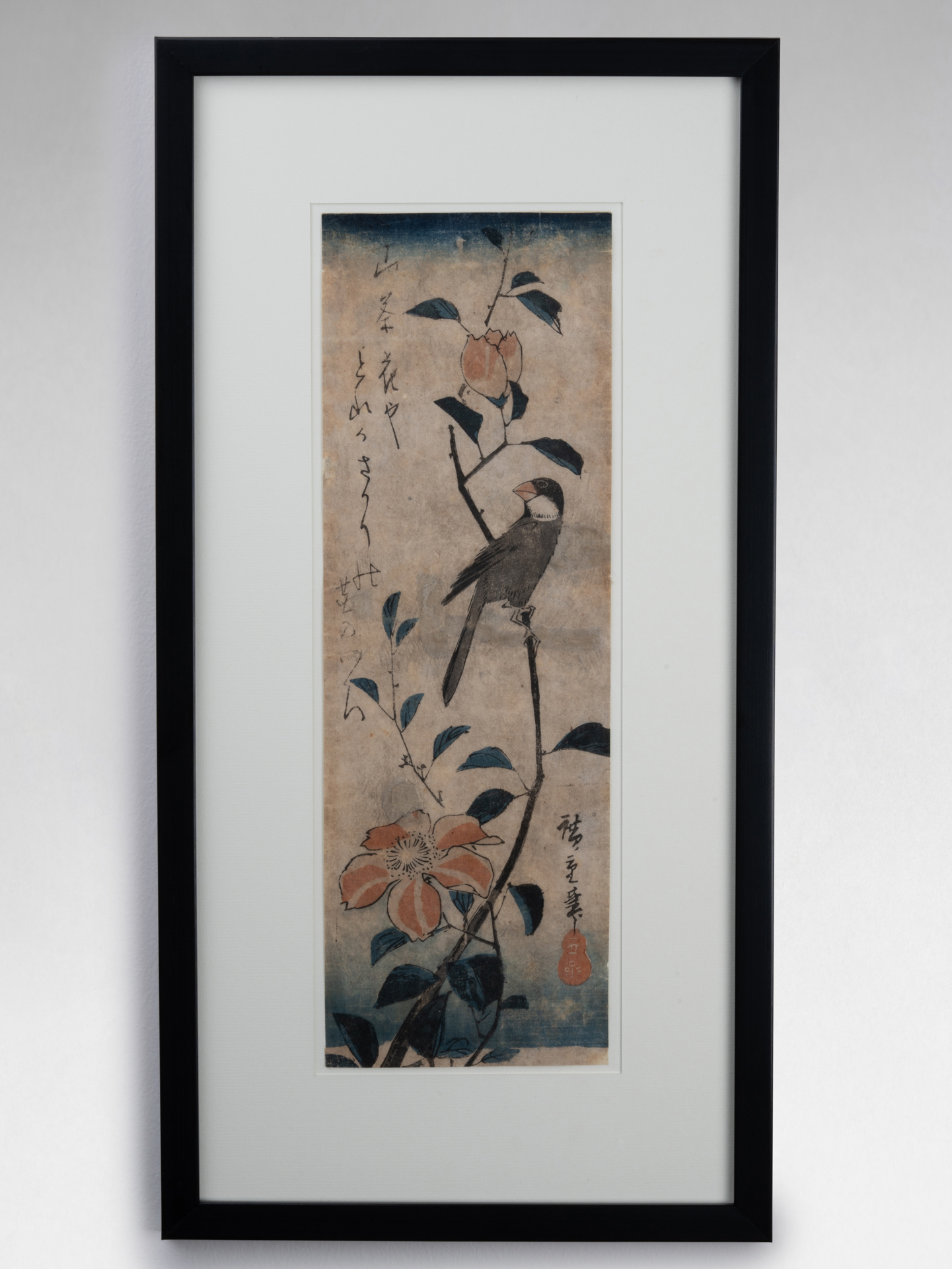
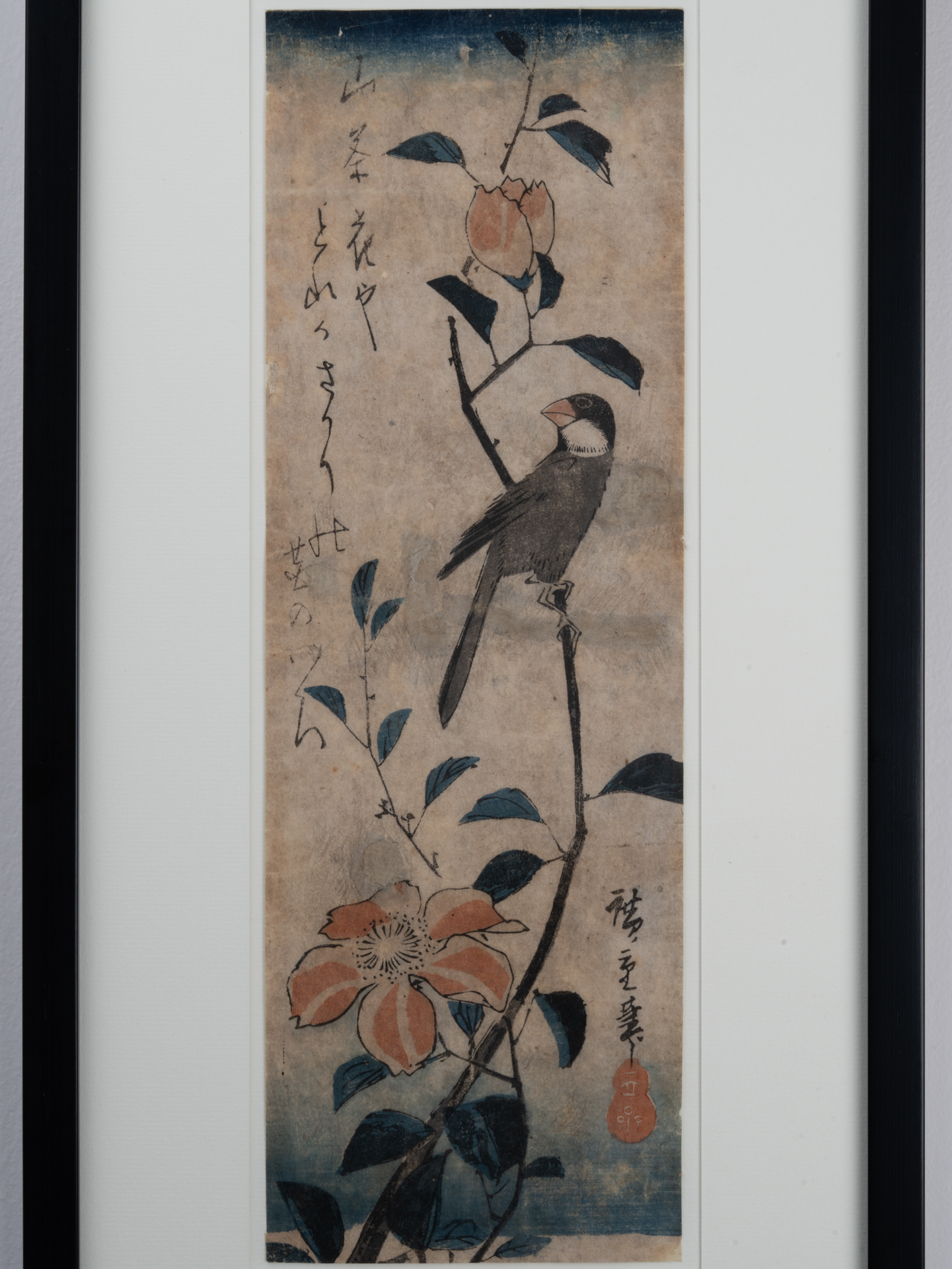
Hiroshige – Estampe originale. Série des fleurs et oiseaux. Japon Edo, 19e siècle. Format Chutanzaku. Hauteur : 33 cm – Pièce encadrée : 47 cm.
Hiroshige – Original japanese print. Flowers and birds. Japan Edo, 19th century. Chutanzaku. H : 33 cm – Framed : 47 cm.
Estampe – Koson Ohara (1877-1845) Couple de daims
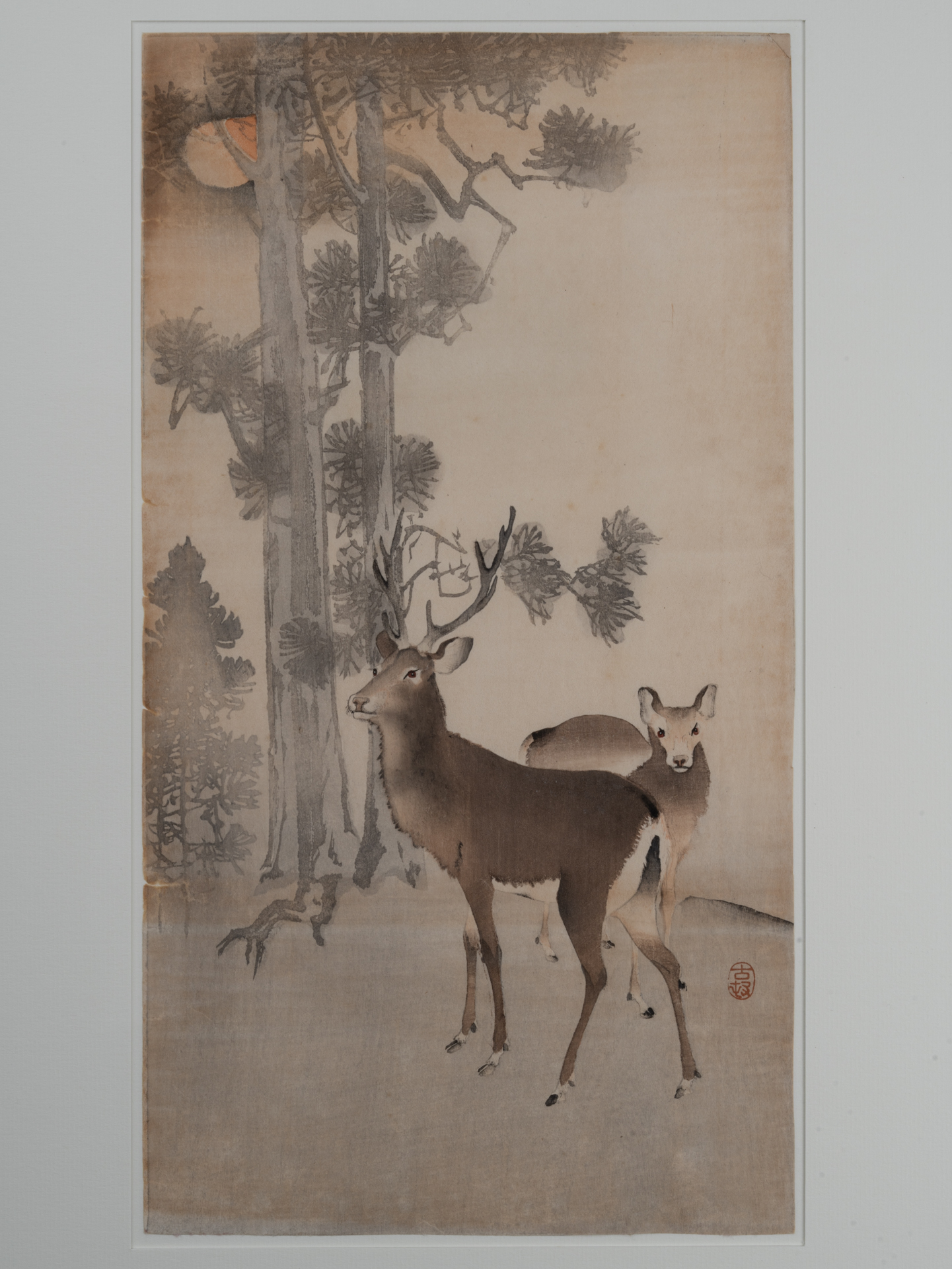
Koson Ohara (1877-1845) Couple de daims dans un paysage. Editeur : Daikokuya. Vers 1900, 1910. Taille 18,3 x 33,7 cm. Dans un encadrement sur mesure. Koson Ohara était l’un des grands graveurs du XXe siècle au Japon, reconnu pour ses gravures kacho-e d’oiseaux et de fleurs. Originaire de Matao, il est né à Kanazawa, dans la préfecture d’Ishikawa.
Koson Ohara (1877-1845) A Pair of Deer Publisher: Daikokuya Date: c.1900s-1910s Size: 18.3 x 33.7 cm. Perfectly framed. Koson Ohara was one of the great printmakers of the 20th century, best known for his kacho-e prints of birds and flowers. Originally Matao, was born in Kanazawa, Ishikawa prefecture.
Estampe – Katsushika Hokusai (1760–1849) Takaïdo – Chiryu, 1804
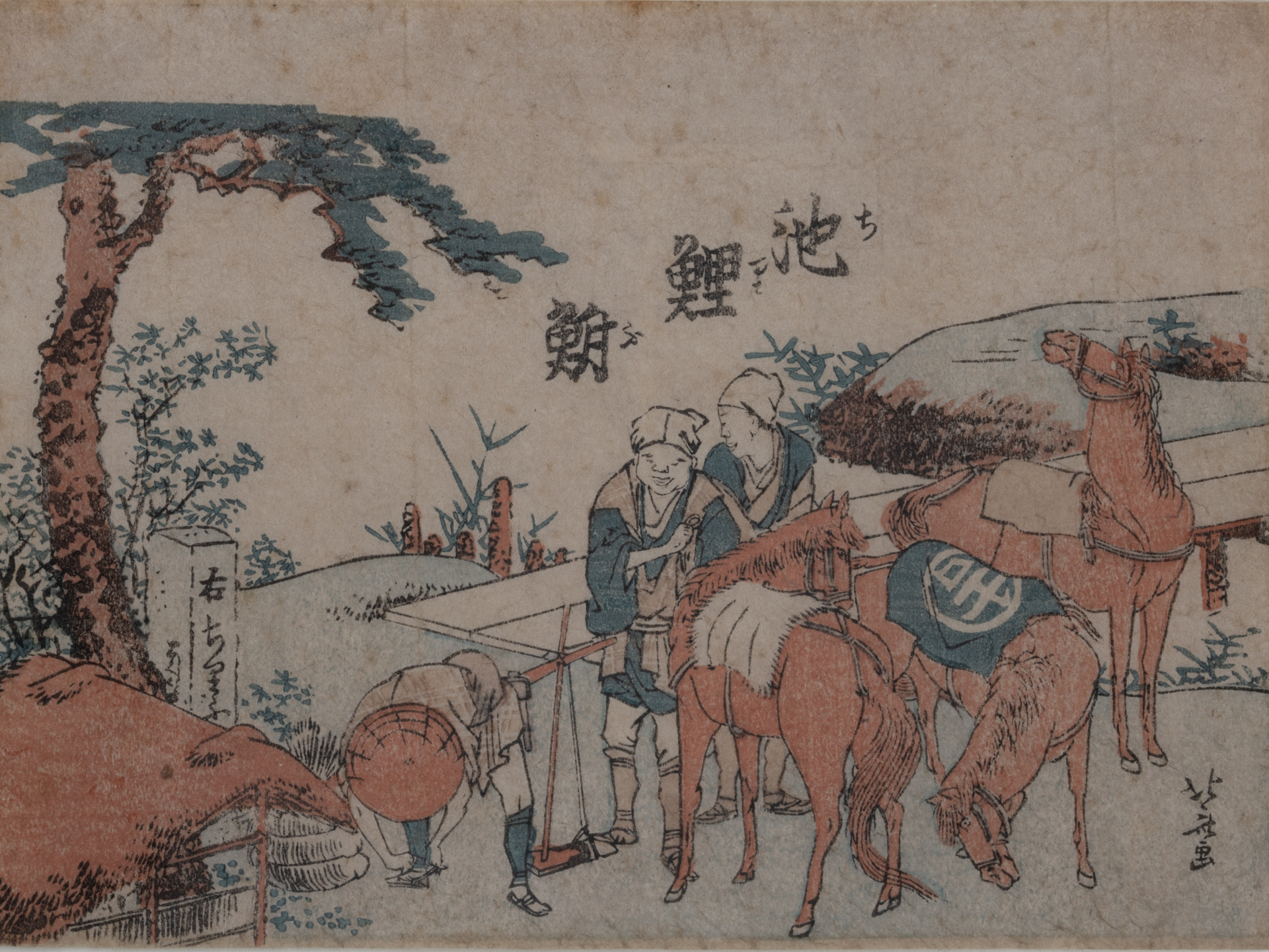
Katsushika Hokusai (1760–1849) Takaïdo – Chiryu, 1804. Estampe japonaise originale. Première série sans titre des 53 stations de la route du Tokaïdo. Format horizontal de type Kokonotsugiri-ban Nishikie. Encre et couleurs sur papier. Encadré sur mesure. Le dessin met d’avantage l’accent sur les personnages que sur les paysages, en se concentrant sur les voyageurs, les citadins, les marchands et les ouvriers rencontrés le long de cette célèbre route. Soigneusement détaillées ces charmantes scènes capturent magnifiquement la vie le long du Tokaido à l’époque d’Edo.
Katsushika Hokusai (1760–1849) Takaïdo – Chiryu 1804 (Kyôwa 4/Bunka 1) Woodblock print (nishiki-e); ink and color on paper Size : Horizontal kokonotsugiri (one-ninth ôban). Perfectly framed. Lovely designs emphasize figures rather than scenery, focusing on the travelers, townspeople, merchants, and laborers encountered along this famed road. Carefully detailed and softly colored, these charming scenes beautifully capture life along the Tokaido in the Edo era.
Netsuke par Kokei – Exceptionnel modèle de loup
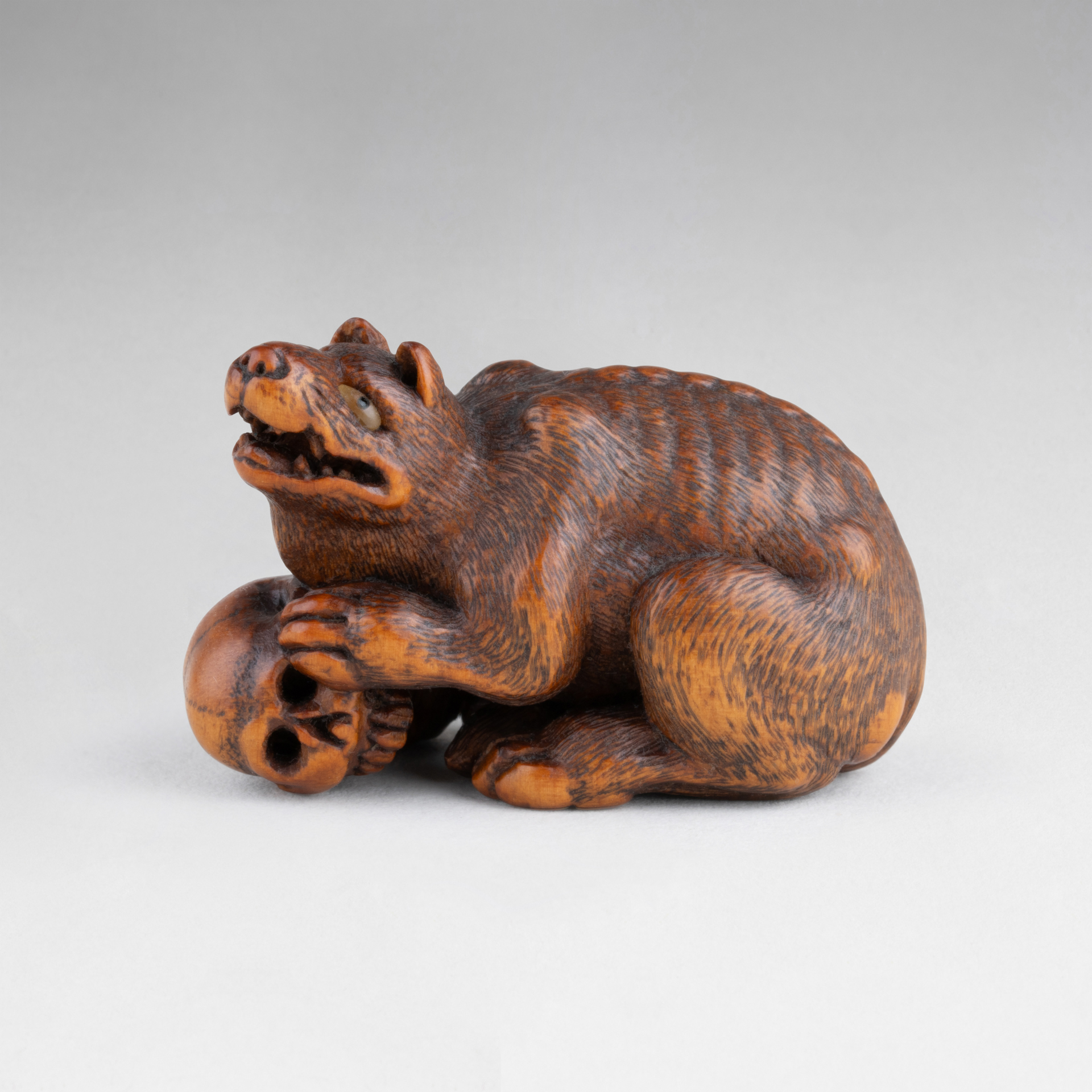
Netsuke par Kokei – Exceptionnel modèle d’un loup, la patte retenant un crâne. Les yeux sont en double incrustation. Japon Edo (1603-1968) XIXe siècle. Provenance : Collection Hartman. Mise en comparaison avec une pièce similaire de même qualité (ci-dessous), dont le crâne est manquant. Il s’agit d’une œuvre de Kokei située au MET de New York, Edward C.MOORE collection, 1891.
Netsuke by Kokei. A very important model of a wolf. A wild dog crouching over a skull, the eyes inlaid in horn and ebony. Japan Edo (1603-1868) 19th century. Provenance : Hartman Collection. A very similar exemple here attached, from the MET of New York, for the Edward C.MOORE collection, 1891.
Netsuke – Important shishi en buis sculpté
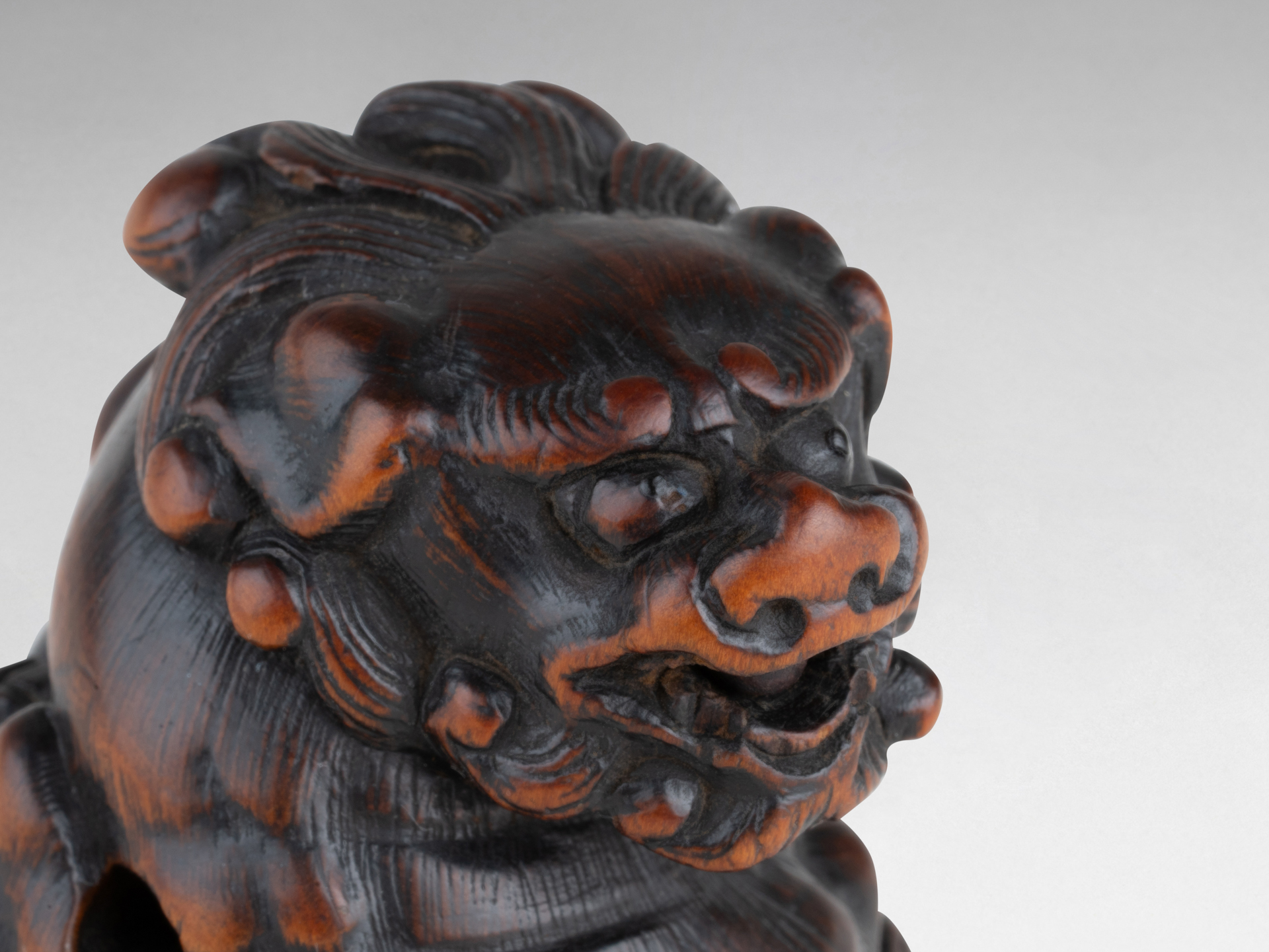
Netsuke – Important et puissant model de Shishi représenté assis, en bois sculpté (buis), La tête très expressive, complètement tournée vers l’arrière, les pattes avant en mouvement, reposant sur sa balle. Incrustations pour les yeux. Très belle patine naturel du bois. Hauteur : 3,4 cm. Japon Edo (1603-1868) 18e siècle. Provenance : Ancienne collection Hartman.
Netsuke – A strong and compact model of a shishi seated (Chinese mythical lion), powerfully carved and with a beautiful natural patina. Its head completely turned back to the right, the paws turning on a ball. Eyes are inlaid. Height : 3,4 cm. Japan Edo (1603-1868) 18th century. Provenance : From the Hartman collection.
Rare Kobako en forme de tissu noué
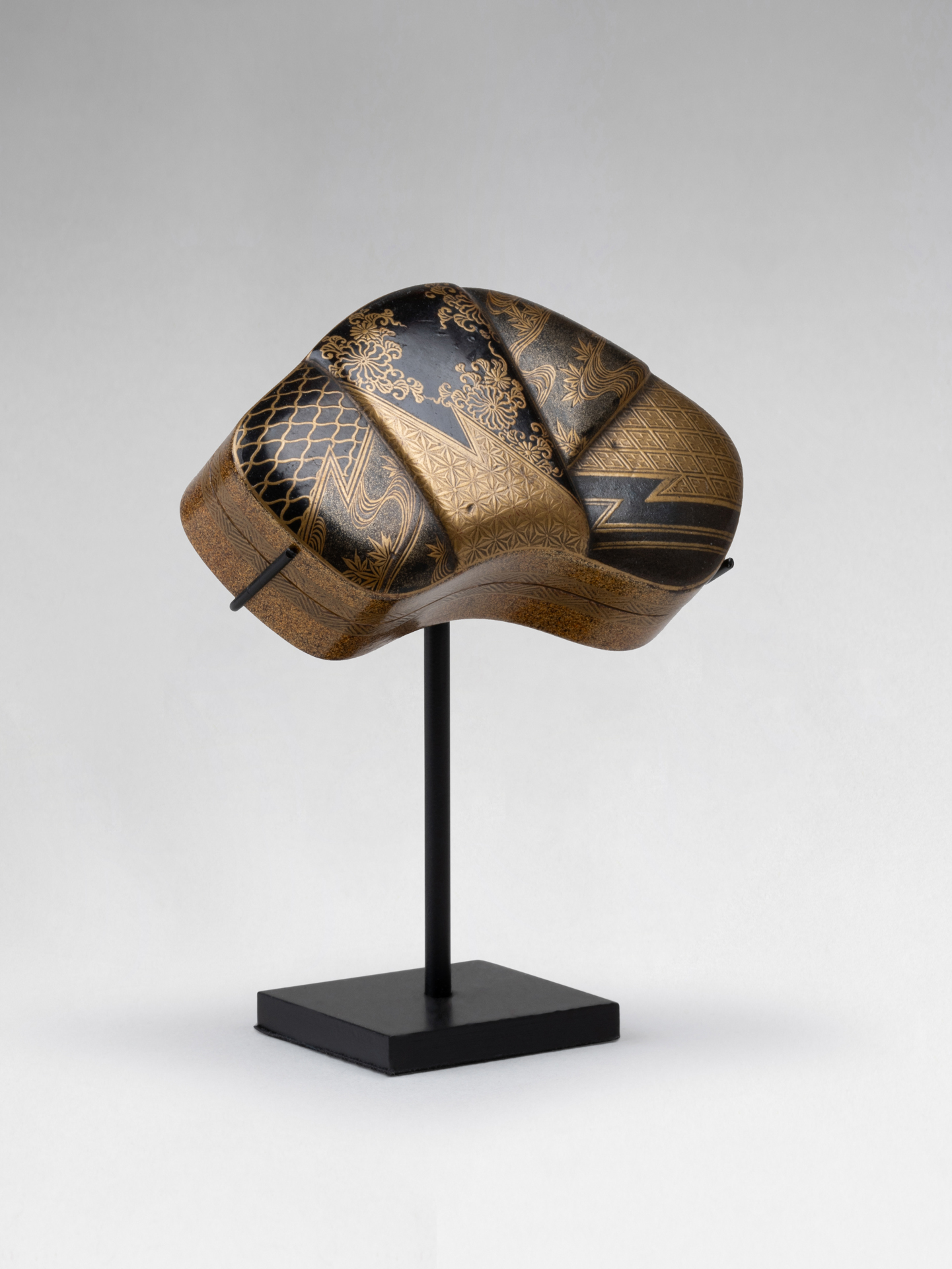
Rare et ravissant Kobako, en forme d’un tissu noué, en laque du Japon urushi. Décor en laque sur le couvercle offrant un décor de style Kodaiji, comprenant des motifs en laque d’argent et d’or en maki-e, de brocards, de feuilles d’érables, de cours d’eau et de kiku. Le dessous avec des aiguilles de pin et des feuilles d’érable. Nashiji sous la base. d’argent et ‘or en maki-e à motifs de brocards, de feuilles d’érables, de cours d’eau et de kiku. Intérieur en laque nashiji. Ancienne étiquette portant la mention : Boite offerte à Dominique par Mademoiselle Gobart le 16 novembre 1932 – lot 102 bis. Japon Edo (1603-1868) entre la fin du 17e siècle et le début du 18e siècle.
Unusual and very small Kobako of japanese urushi lacquer, in the form of a knotted cloth. The cover with Kodaiji style design, comprising areas of diaper pattern, of silver and gold lacquers, of maple leaves in a stream, a net and stylised florettes, the underside of the cover with pine needles and maple leave. Nashiji under the base. Width 6.3cm. Japan Edo (1603-1868), end of 17th century, early 18th century. Provenance : An old label from a french collection, dated 1932.
Netsuke – Shishimaï, en bois sculpté
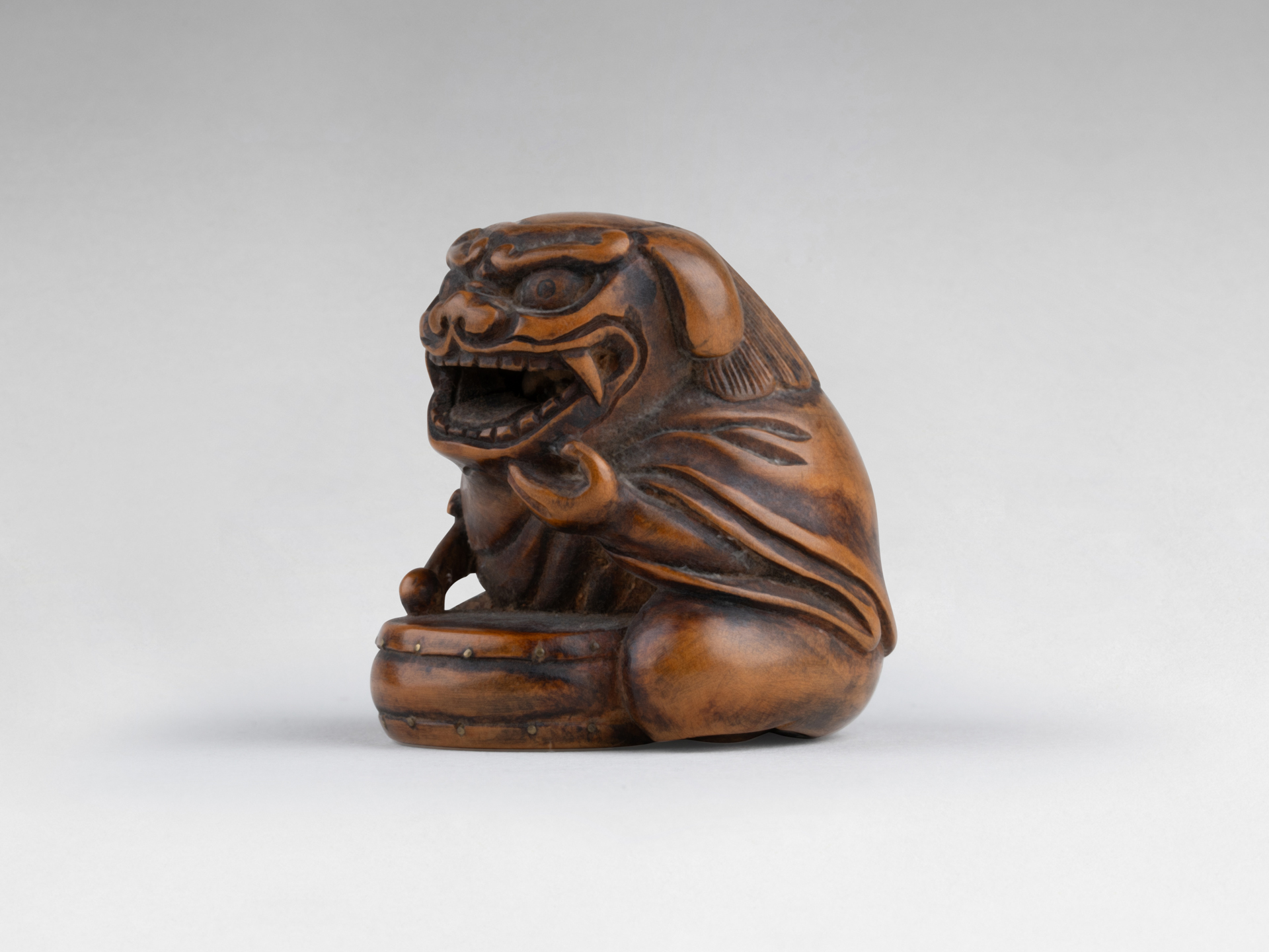
Netsuke – Shishimaï. En bois sculpté, il représente un jeune homme vétu du costume du Shishi, jouant du tambour. La tête du jeune homme est visible sous le masque. Japon Edo (1603-1868) XIXe siècle
Netsuke – Shishimaï. Wood sculpture of a man wearing a mask of Shishi, playing drum. We can see the face under the mask. Japan Edo (1603-1868) 19th century.
Netsuke par Tomonobu, Coquillages
Netsuke par Tomonobu – Coquillages. Palourdes sur un ormeau. Très belle patine naturelle. Signé Tomobonu dans un cartouche. Japon Edo (1603-1868) 18e siècle. Une étiquette ancienne de collection portant le numéro 51.
Netsuke by Tomonobu – Sea Shells. Clams and abalone. Beautiful patina. Signed Tomonobu in a reserve. Japan Edo (1603-1868) 18th century. An old label with the number 51.
Important brûle-parfum / encensoir à décor d’oiseaux et d’un grand Shishi
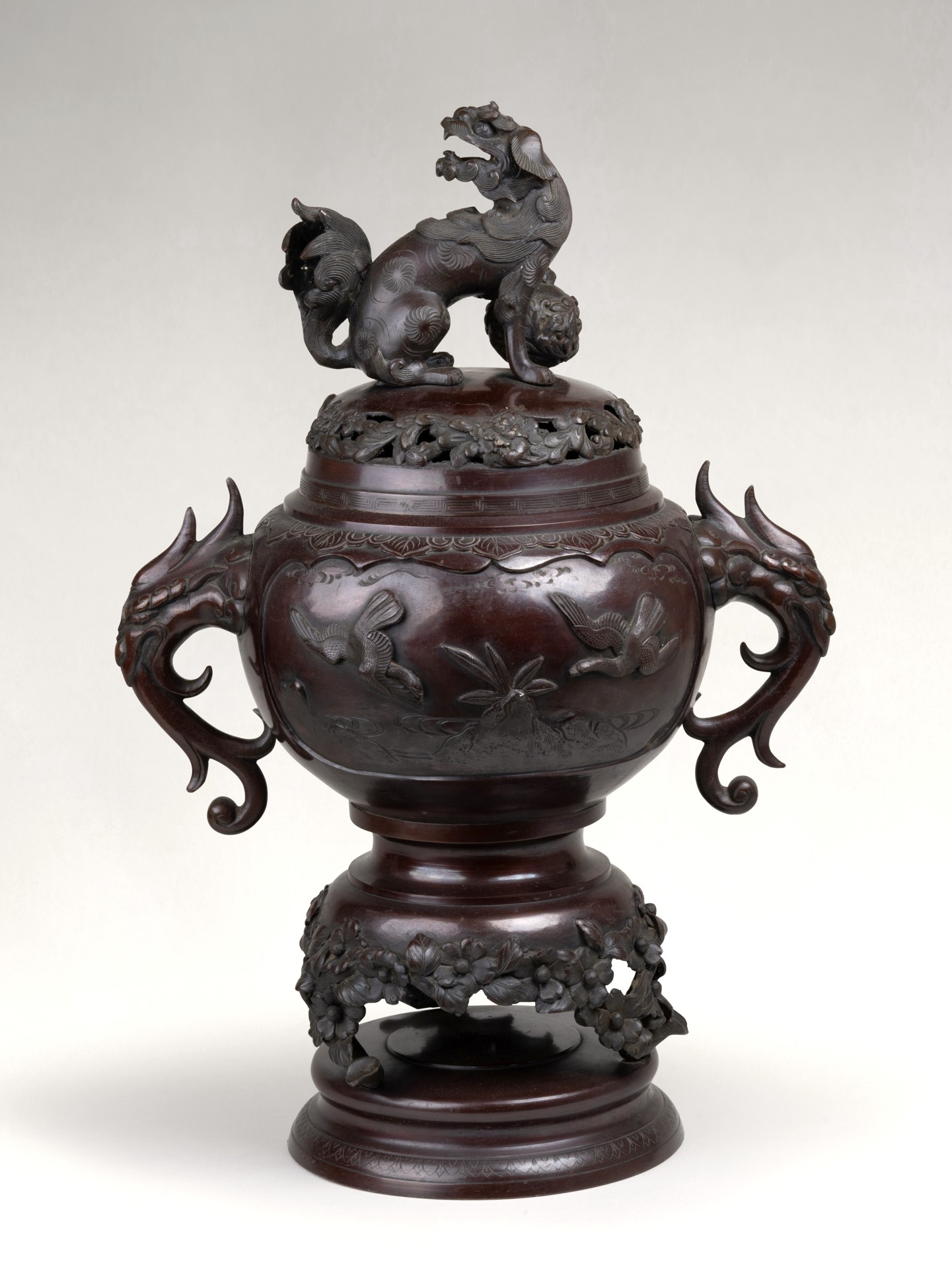
Important brûle-parfum / encensoir – Koro. Il repose sur une base circulaire, réhaussé par trois pieds à décor de branches fleuries et oiseau. Deux larges anses représentant des dragons. Oiseaux en vol dans un paysage dans chacun des cartouches centraux. Le large couvercle est orné d’un grand Shishi la tête tournée vers l’arrière, rugissant. Hauteur : 58 cm. Japon Meiji (1868-1912) Vers 1860, XIXe siècle
An important tripod bronze incense burner / censer – Koro. In front and back, two lobed panels decorated with relief scenes with birds on a landscape. Dragon handles. The cover with a bid Shishi, the head turn to the back. 58 cm. Japan Meiji (1868-1912) 19th century.
Inro – Pivoines et chrysanthèmes
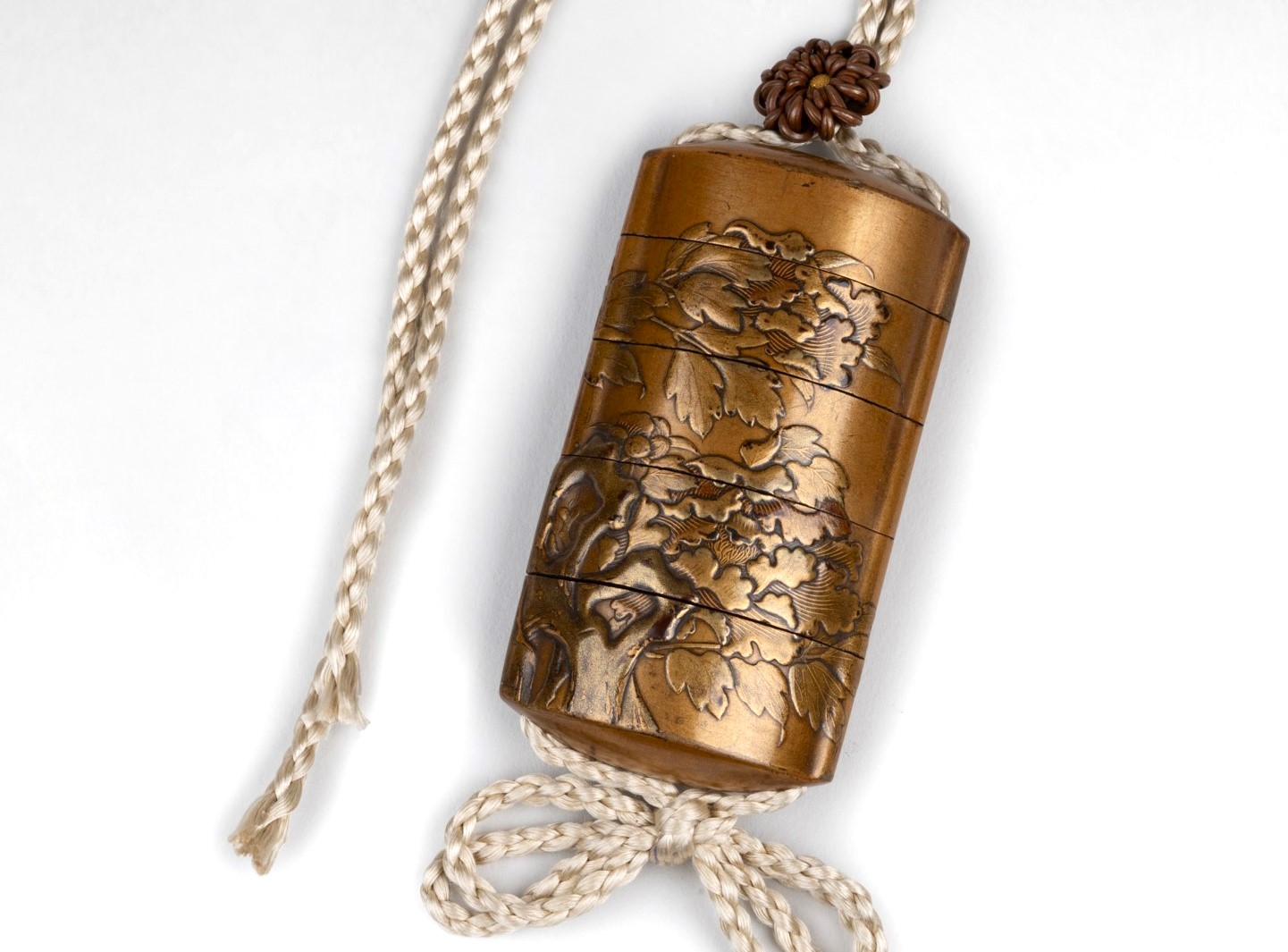
Inro Kajikawa – En laque d’or, à décor de pivoine en fleurs et rochers sur fond or. Ojime en forme de chrysanthème. Hauteur : 8 cm. Signé sous la base. Japon Edo (1603-1868) XIXe siècle.
Inro Kajikawa – A beautiful model of an Inro open by cases and a lid, with peonies and rocks, on a gold background. Hight : 8 cm. An Ojime of a chrysanthemum. Signed under the base. Japan Edo (1603-1868) 19th century.
Netsuke par Tametaka, Coq sur tambour
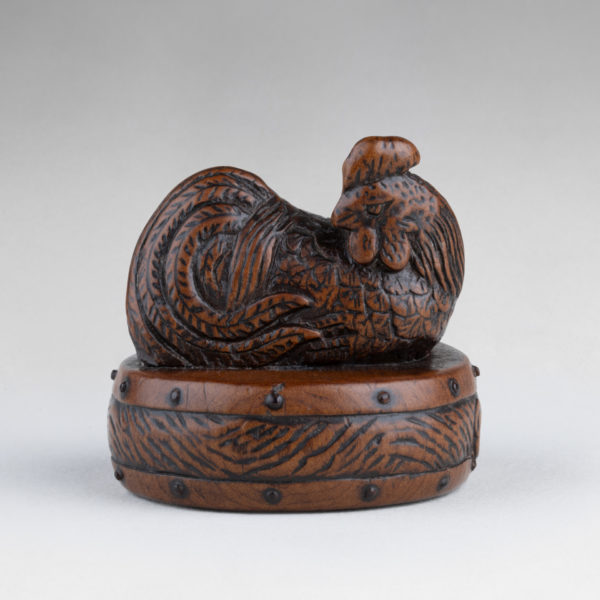
Netsuke par Tametaka. Ravissant modèle en bois sculpté représentant un coq perché et couché sur un tambour, regardant vers l’arrière. Signé sous la base. Modèle de belle dimensions. diamètre : 4 cm. Japon Edo -1603-1868) 19e siècle. Le coq sur le tambour est symbole de paix. En effet, les tambours utilisés pour appeler les troupes en guerre n’ayant plus d’utilité en période de calme, se retrouvaient occupés par les animaux, dont les coqs.
Netsuke by Tametaka. A wood model depicting a rooster / coquerel resting on a drum. The long-tailed fowl sits perched on a war drum, looking back to his right. Horn inlay. Signed under the base. Good size. Diameter : 4 cm. Japan Edo (1603-1868) 19 th century. A rooster resting on a war drum is symbolic of a peaceful era. The war drum was used to call troops to arms, but having fallen into disuse, it has become a perch for fowl.
Netsuke – Personnages et cheval dans une barque
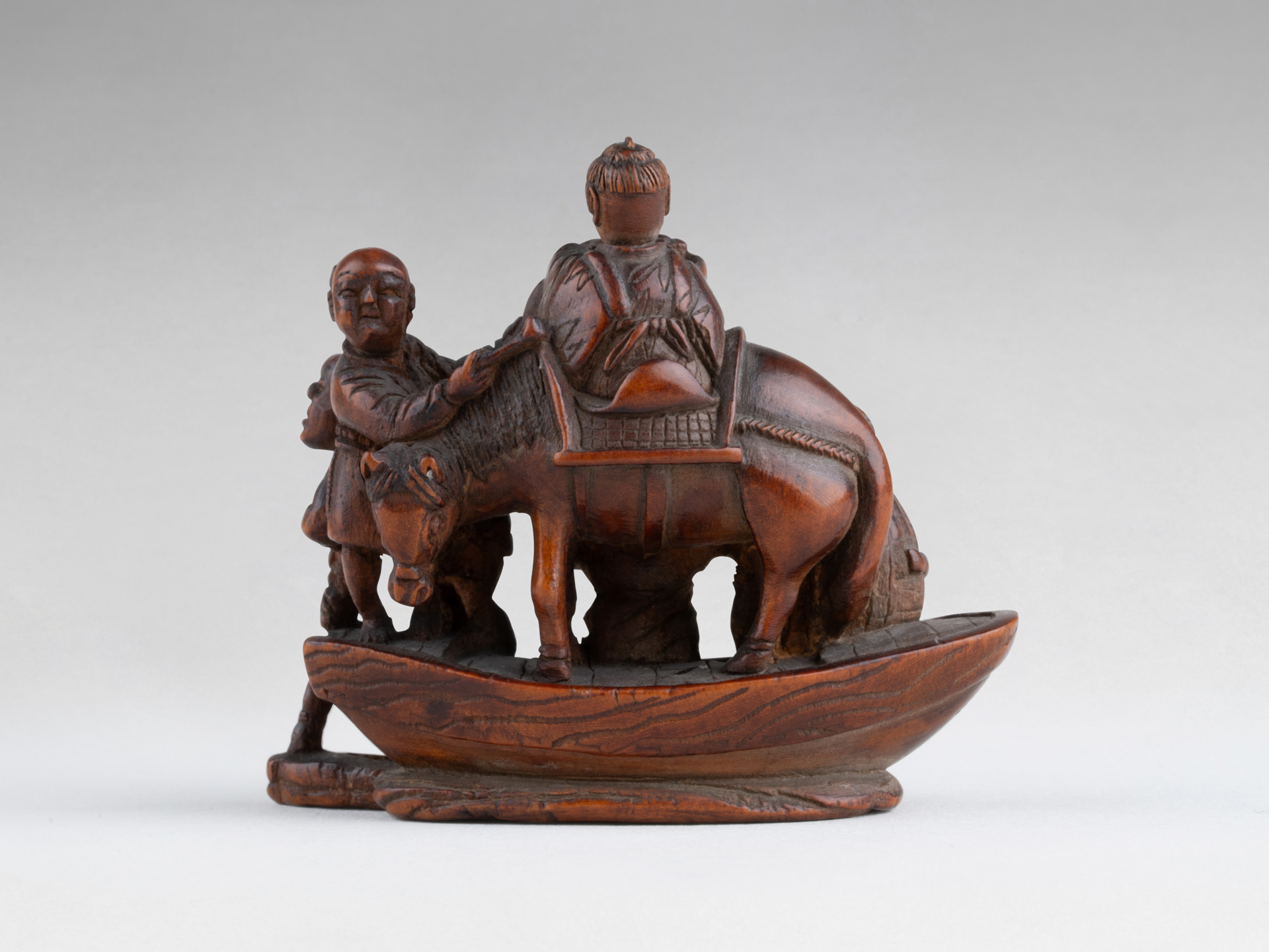
Netsuke – Joli sujet en bois sculpté représentant une barque, avec un cheval et plusieurs personnages, chargés de sacs de marchandises, le barreur penché en avant. Longueur : 5,3 cm. Signé sur le devant de la barque : Norishige. Japon Edo (1603-1868) début Meiji (1868-1912) 19e siècle
Netsuke – A wood sculpture of a boat, with a horse and many characters, carrying bags. Length : 5,3 cm. Signed in front of the boat : Norishige. Japan end of Edo (1603-1868) early Meiji (1868-1912) 19th century.
Netsuke – Deux singes par Itsumin
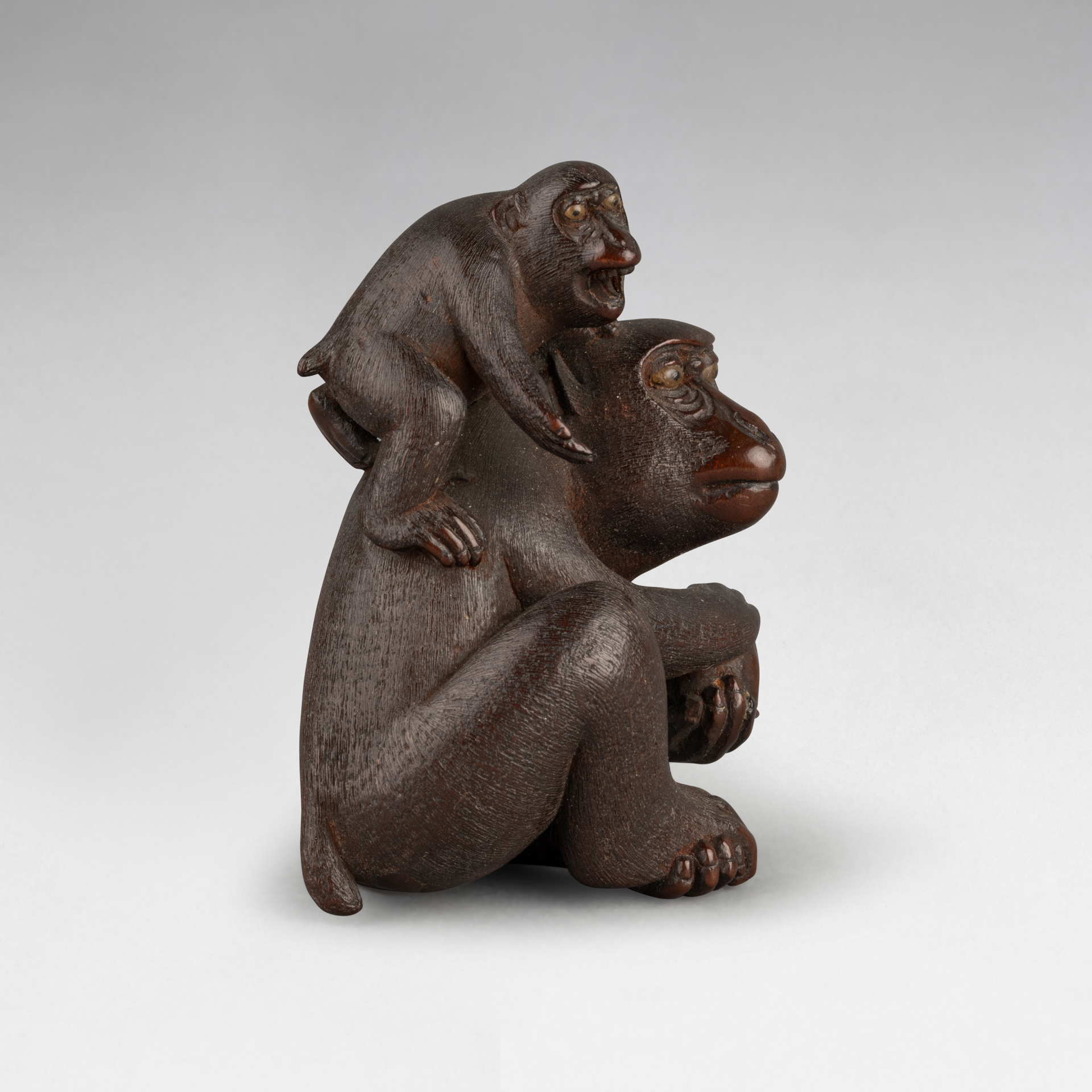
Netsuke – Par Hokyudo Itsumin. Deux singes finement sculptés. Le plus petit grimpant sur le dos du grand singe. Les regards très expressifs. Signé sous la base. Ravissants détails de sculpture. Double incrustation pour les yeux. Hauteur : 7 cm. Japon fin Edo, 19e siècle.
Netsuke – By Hokyudo Itsumin, signed Itsumin. Two finely carved monkeys. The smallest climbing on the back of the big one. Very expressive heads. Signed under the base. Very fine sculptural details. The eyes are double inlaid in pale and dark horn. H: 7 cm. Japan, Edo (Tokyo), end 19th century, Edo period
Prix sur demande – Price on request
Suzuribako – Coffret écritoire au Shishi
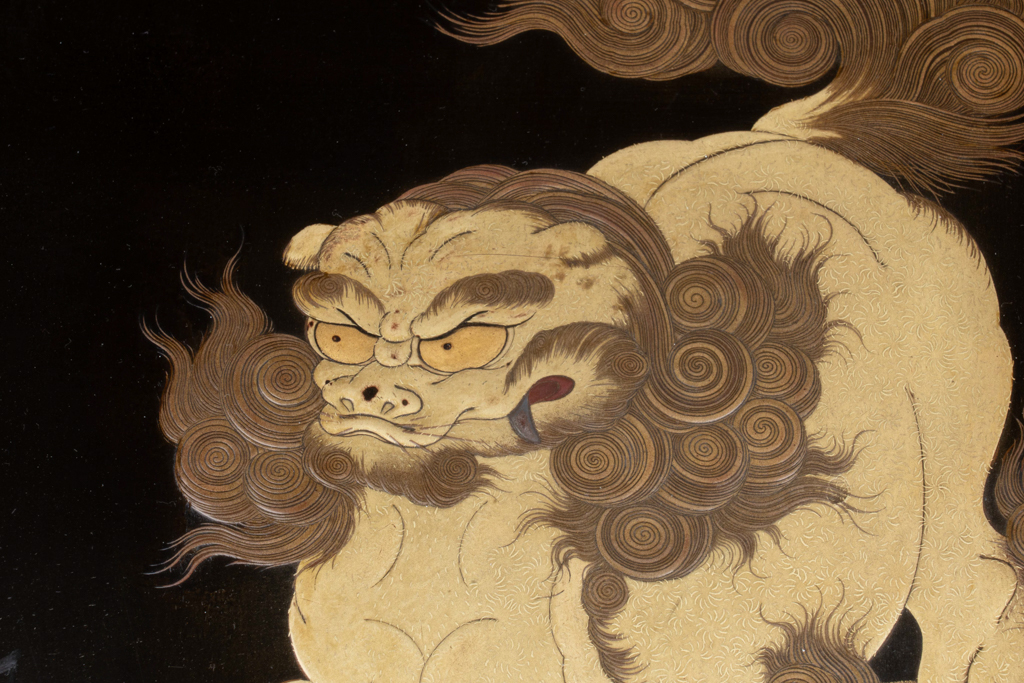
Suzuribako – Coffret écritoire en laque du Japon urushi, ouvrant par un couvercle, à décor d’un grand shishi sur fond noir. Au dos du couvercle, des oiseaux en vol au dessus des flots. Intérieur en laque nashiji. Dimensions : 25 cm x 22 cm. Japon Meiji (1868-1912) fin du 19e siècle.
Suzuribako – A fine lacquer box and cover depicting a buddhistic lion within a landscape, the interior depicting birds and foliage on a nashiji background. Dimensions : 25 cm x 22 cm. Japon Meiji (1868-1912) end of 19th century.
Tanuki en bronze
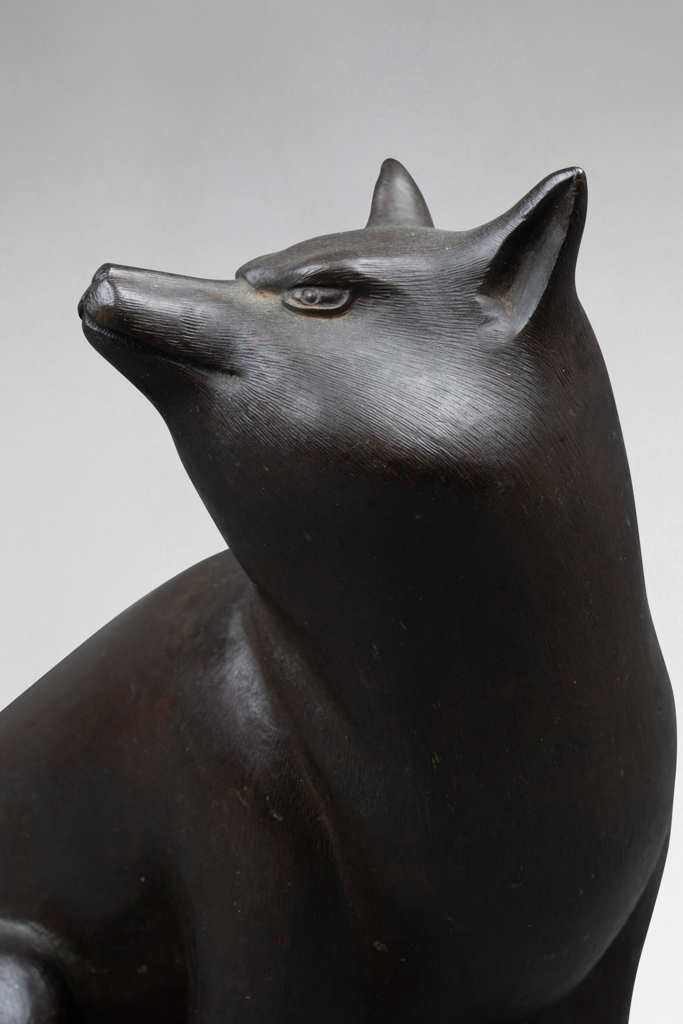
Bronze – Joli model d’un Tanuki, représenté assis, la tête très expressive, tournée vers la droite. Belle finesse de sculpture. Hauteur : 14 cm. Japon Meiji (1868-1912) fin du 19e siècle.
Bronze – A good model of a Tanuki, seated, its head turned to the right. Fine detail of sculpture. H : 14 cm. Japan Meiji (1868-1912) end of 19th century.
